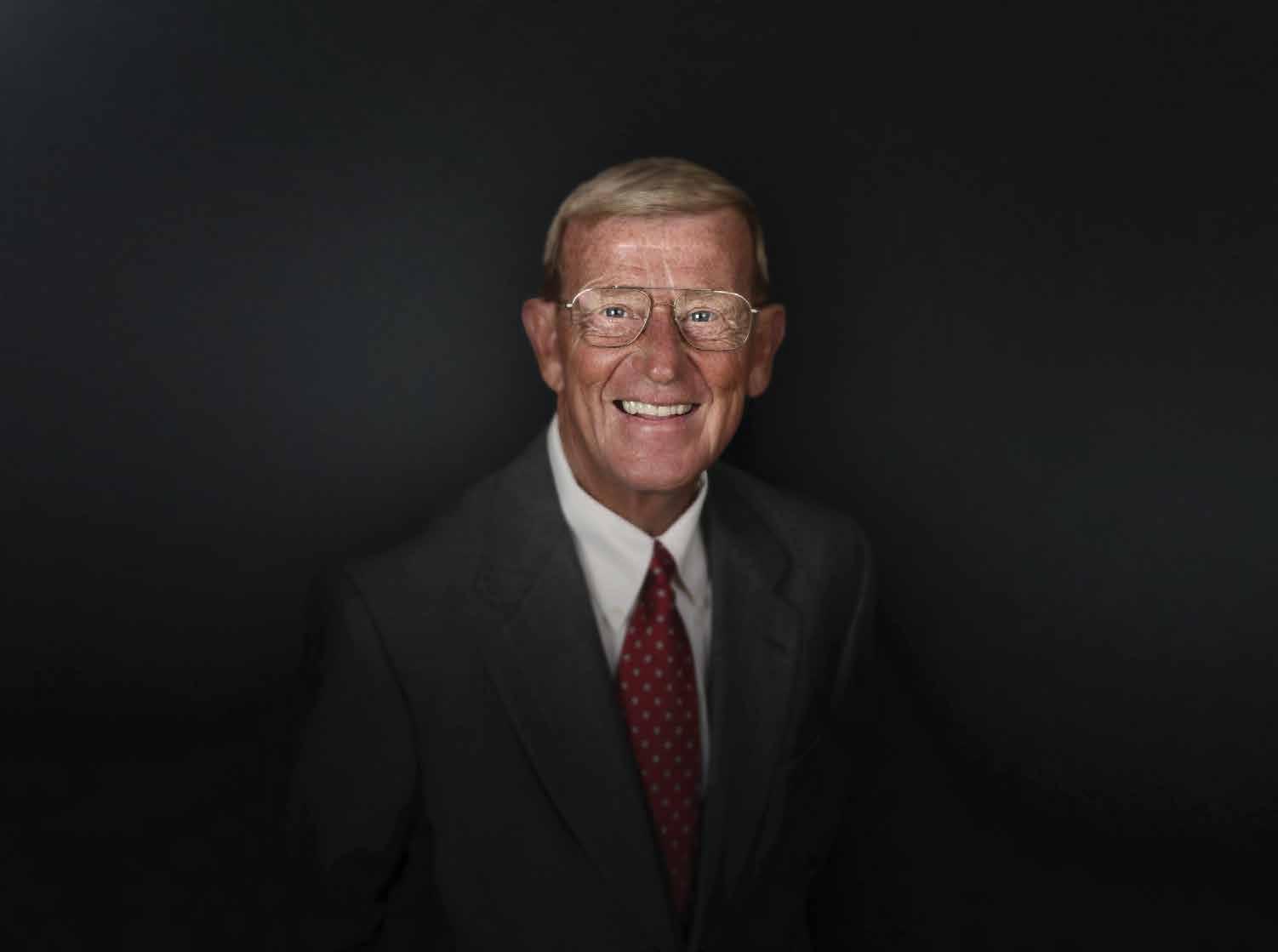


Our Marketing team volunteered at Hannah’s Treasure Chest in Miamisburg, which provides care packages to children.
Our employees joined forces with BOGG Ministries in Miamisburg to ensure local families enjoy a hearty Thanksgiving meal.




Our Marketing team volunteered at Hannah’s Treasure Chest in Miamisburg, which provides care packages to children.
Our employees joined forces with BOGG Ministries in Miamisburg to ensure local families enjoy a hearty Thanksgiving meal.
At the heart of our mission is serving our clients and communities. Our passionate, caring team takes the time to understand your unique needs, offering personalized guidance for individual, family, or Medicare health insurance.
Whether you’re exploring new health plans or reviewing your current coverage, we’re here to offer year-round support and peace of mind. Let us help you find health insurance that fits your needs, while advocating for you whenever you need us.

The Catechism of the Catholic Church tells us, “The desire for God is written in the human heart.” We long for God, for His grace. This echoes St. Augustine’s famous declaration to God that “Our hearts are restless until they find their rest in Thee.” I believe this to be true. But I also believe the words that Flannery O’Connor wrote in a 1958 letter to her friend Cecil Dawkins, “All human nature vigorously resists grace because grace changes us, and the change is painful.” We simultaneously desire God and vigorously resist Him.
The times of change—of transition—in my life stand out in my memory as some of the most painful; sometimes physically, sometimes emotionally. I am a mother of four children. My youngest was born 9 months ago; the fear and pain I felt during the transition phase of labor are still poignant in my memory. It was the moment that my confidence failed. The moment that I clung to my husband in terror, believing I could not endure the pain. But that transition brought George into my arms. And in George, I so clearly see the face of God.
I’ve been called temporarily to fill the editorial director’s position for The Catholic Telegraph. This is a big shift from my normal professional responsibilities as video producer for the archdiocese. I instinctively balked at the invitation, wary of the inevitable growing pains ahead. But God has been faithful in this transition, reminding me that I am not alone in bringing this magazine to your mailbox. Jessica Rinaudo left a strong foundation for us to build upon. And my colleagues’ rallying camaraderie has been an enormous gift. We’ve all felt the loss, and we’ve all experienced the growing pains, but we’ve all felt God present among us during this time of transition.
This month the faithful of the Archdiocese of Cincinnati are joined together in the transition from one archbishop to another. This change, while a joyful one, is tinged with sadness. But the promise of grace is closely intertwined with the pain of change. We will dearly miss Archbishop Schnurr, our devoted spiritual father. But we look forward with great anticipation to follow the way of our new shepherd, Archbishop Robert G. Casey.
My mark on this nearly 200 year old publication will be modest and temporary. But that does not make it insignificant. Just like today, no matter what I am called to do, it is not an indifferent day to my salvation. Although I may write only a letter or two from the editor’s desk before returning to my previous position, I trust in the Lord that I do not labor in vain. It is an honor to write to you, the faithful of the Archdiocese of Cincinnati, for this short period of time. I pray that, today, we all take courage in embracing grace and that we allow Him to change us.
Margaret Swensen
cteditorial@catholicaoc.org
Publisher: Archbishop Dennis M. Schnurr
Interim Editor: Margaret Swensen
Graphic Design: Emma Cassani
Media Sales: Deacon Graham Galloway
New Media / Circulation: Greg Hartman
Digital Engagement: Colin Rahill
Social Media: Taylor Motley
Photography: Margaret Swensen and Danny Schneible

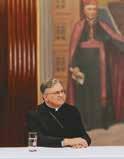

Dr. Kenneth Craycraft
kcraycraft@catholicaoc.org
holds the James J. Gardner Chair of Moral Theology at Mount St. Mary’s Seminary & School of Theology. He is the author of Citizens Yet Strangers: Living Authentically Catholic in a Divided America.

Father David Endres
dendres@catholicaoc.org
is professor of Church history and historical theology at Mount St. Mary’s Seminary & School of Theology.

Dr. Andrew Sodegren
asodergren@ catholicaoc.org
is a Catholic psychologist and director of psychological services for Ruah Woods. He speaks on the integration of psychology and the Catholic faith. He and his wife, Ellie, have five children.

Emma Cassani
ecassani@catholicaoc.org
is the graphic designer behind The Catholic Telegraph. She is passionate about exploring the intersection between art and faith.

Colin Rahil
crahill@catholicaoc.org
is the Director of Digital Engagement for the Archdiocese of Cincinnati, as well as a writer and speaker.

Katie Sciba
ksciba@catholicaoc.org
is a national speaker and Catholic Press Award winning columnist. Katie has been married for 15 years and is blessed with six children.
APRIL
Let us pray that the use of the new technologies will not replace human relationships, will respect the dignity of the person, and will help us face the crises of our times.

For these past fifteen years it has been my great privilege to serve as the Archbishop of Cincinnati. With the acceptance of my resignation and the appointment of the next archbishop, an opportunity presents itself to reflect on these years of priestly ministry.
This is a bittersweet moment for me. On the one hand, I look forward to passing on the reins of ecclesiastical administration to my successor. On the other, I will miss the experiences of active ministry through which I had the opportunity to interact with so many of you. One never truly retires from being a priest, though, and I look forward to assisting as I am able with the celebration of the sacraments in service to the faithful of this archdiocese.
It is through the sacraments that Christ is made present to us. He nourishes us, forgives our sins, gives us the strength to fulfill our respective vocations, and protects us on our final journey back to the God who created us. It has been a special grace to witness the many ways in which Christ is at work in your lives and continually cares for His flock. Jesus promised to remain with us to the end of time. To the faithful of this archdiocese and beyond, He has kept that promise. I am grateful to have collaborated with many priests, deacons, religious women and men, and lay people to help build up the Kingdom in our local Church.
There have undoubtedly been challenges over the years. Even in these moments, however, when the Cross is more readily present to us, God’s grace triumphs. As Saint Paul reminds us, “All things work for good for those
who love God” (Romans 8:28).
Soon after arriving in the archdiocese, I invited us all to pray frequently for vocations. The Prayer for Vocations is not simply a means of asking God to send us more young people to serve the Church as priests or consecrated religious. Rather, it is a reminder that God has called each of us to some definite purpose in this life. He calls us to be sharers in His mission and He equips us to do our unique part to contribute to the faith journey of the entire People of God. There is much good happening across this archdiocese, and that is due to the faithfulness with which so many of you are striving to know and follow your vocation.
From the beginning of His ministry, Jesus called men and women to follow Him. He continues to call us today. Our response demands that we constantly seek the face of the Lord—to recognize His presence in our lives and enter into relationship with Him. This is essential to the life of a Christian, and because of that I chose those words, Seek the Face of the Lord, as my episcopal motto. We constantly seek Him and, in knowing Him, we then bring others to experience His love for them. This is how I have approached my own vocation, and I hope that in some way God has worked through my priestly ministry to be present to you.
Know of my prayers for all of you, and please pray for me as I enter this new phase of my vocational journey with the Lord. Please pray as well for Archbishop-designate Casey, that the Lord may guide and strengthen him as he takes on the responsibility of being our archbishop and shepherd.

CARTA A LOS FIELES | Arzobispo Dennis M. Schnurr
Durante estos últimos quince años he tenido el gran privilegio de servir como el arzobispo de Cincinnati. Con la aceptación de mi renuncia y el nombramiento del próximo arzobispo, se presenta la oportunidad de reflexionar sobre estos años de ministerio sacerdotal.
Este es un momento agridulce para mí. Por una parte, espero poder pasar las riendas de la administración eclesiástica a mi sucesor. Por otro lado, extrañaré las experiencias de ministerio activo a través del cual tuve la oportunidad de interactuar con muchos de ustedes. Sin embargo, uno nunca se retira verdaderamente de ser sacerdote, y espero poder ayudar en lo que pueda con la celebración de los sacramentos al servicio de los fieles de esta arquidiócesis.
Es a través de los sacramentos que Cristo se hace presente entre nosotros. Él nos nutre, perdona nuestros pecados, nos da la fuerza para cumplir nuestras respectivas vocaciones y nos protege en nuestro camino final de regreso al Dios que nos creó. Ha sido una gracia especial presenciar las muchas maneras en que Cristo está trabajando en sus vidas y cuida continuamente de Su rebaño. Jesús prometió permanecer con nosotros hasta el fin de los tiempos. A los fieles de esta arquidiócesis y más allá, Él ha cumplido esa promesa. Estoy agradecido de haber colaborado con muchos sacerdotes, diáconos, religiosos, religiosas y laicos para ayudar a construir el Reino en nuestra Iglesia local. Sin duda, a lo largo de los años ha habido desafíos. Pero incluso en estos momentos, cuando la cruz está más presente ante nosotros, triunfa la gracia de Dios. Como nos recuerda San Pablo: “Sabemos, además, que Dios dispone, todas las cosas para el bien de los que lo aman” (Romanos 8:28).
Poco después de llegar a la arquidiócesis, invité a todos a orar frecuentemente por las vocaciones. La Oración por las Vocaciones no es simplemente un medio para pedir a Dios que nos envíe más jóvenes para servir a la Iglesia como sacerdotes o religiosos consagrados. Más bien, es un recordatorio de que Dios ha llamado a cada uno de nosotros a un propósito definido en esta vida. Él nos llama a ser partícipes de su misión y nos capacita para hacer nuestra parte única para contribuir al camino de fe de todo el Pueblo de Dios. Están sucediendo muchas cosas buenas en esta arquidiócesis, y eso se debe a la fidelidad con la que muchos de ustedes se esfuerzan por conocer y seguir su vocación.
Desde el comienzo de su ministerio, Jesús llamó a hombres y mujeres a seguirlo. Él continúa llamándonos hoy. Nuestra respuesta exige que busquemos constantemente el rostro del Señor: reconocer Su presencia en nuestras vidas y entrar en relación con Él. Esto es esencial para la vida de un cristiano, y por eso elegí esas palabras, Busca el rostro del Señor, como mi lema episcopal. Lo buscamos constantemente y, al conocerlo, llevamos a otros a experimentar su amor por ellos. Así he tratado de vivir mi propia vocación y espero que de alguna manera Dios haya obrado a través de mi ministerio sacerdotal para estar presente ante ustedes.
Cuenten con mis oraciones por todos ustedes y, por favor, oren por mí mientras entro en esta nueva etapa de mi camino vocacional con el Señor. Por favor, oren también por el Arzobispo electo Casey, para que el Señor lo guíe y lo fortalezca mientras asume la responsabilidad de ser nuestro arzobispo y pastor.
The Sisters of Charity of Cincinnati welcome Archbishop-designate Robert Casey and offer our prayerful support as we continue to be “bridge builders.”
We extend our gratitude to Archbishop Dennis Schnurr for his years of service to our archdiocese.

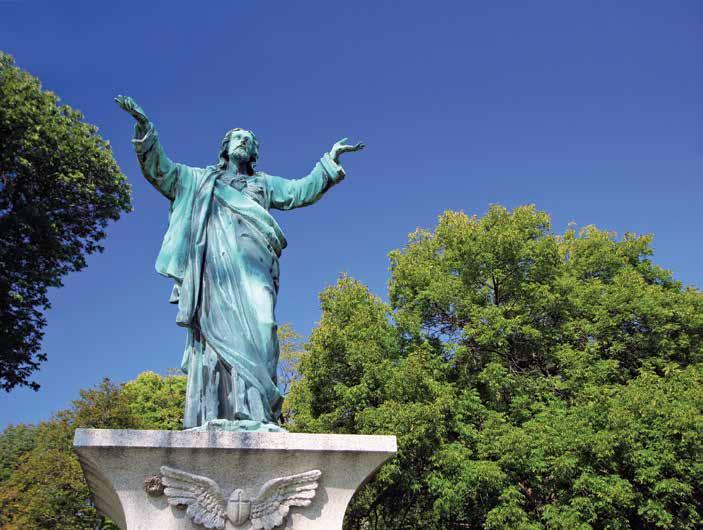
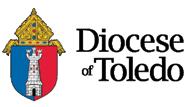


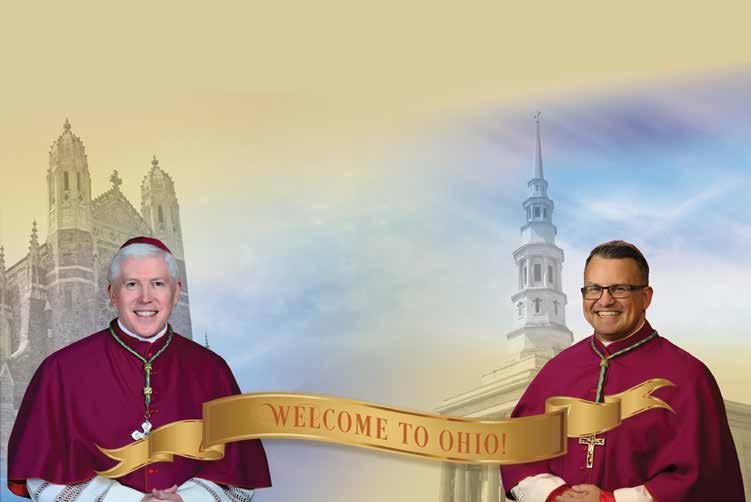
May Jesus, the good shepherd, fill you with every grace to serve the people of God as shepherd of the Archdiocese of Cincinnati faithfully, humbly and joyfully!
his Installation
As the 11th Archbishop of Cincinnati
Bishops fulfill a fundamental office in the Church, an office instituted by Christ when he called the apostles. Through apostolic succession, today’s bishops continue to fulfill roles of governing, teaching and sanctifying.
Though every bishop receives a single episcopal ordination (it is not repeatable), there are different ranks of bishops, including auxiliary bishops, bishops and archbishops. A bishop can move among these ranks according to the responsibilities with which he is entrusted.
Every bishop, including cardinals and the pope himself, shares in a single office. They have each been ordained to the episcopacy, the last of the three ranks of Holy Orders, after diaconate and priesthood.
As bishops, they are marked out for pastoral leadership in communion with the pope, becoming a visible representative of Christ. They have become sharers in Jesus’ life and mission as successors to the first apostles. In this, they are assisted by the Holy Spirit, who constitutes them authentic teachers, shepherds and exemplars of Jesus.
The differences between the ranks of bishop reflect differing responsibilities, jurisdictions and authority. In most cases, a bishop is responsible for the pastoral care of a portion of the People of God—usually delineated by the boundaries of a diocese or an archdiocese. Appointed by and answerable to the pope, they are assisted by priests, deacons and certain members of the lay faithful.
An archbishop is a bishop who holds a higher rank due to his leading an archdiocese, which may be larger or older than
its surrounding dioceses. He has the same responsibilities as other bishops but with the additional role of helping to support nearby dioceses. He is called in particular to guide other bishops who compose his ecclesiastical province, where he is known by the title “metropolitan.” The metropolitan’s unique status is indicated by a special vestment he wears, the pallium, which is a woolen band received from the pope that he can wear in his archdiocese and the other dioceses of his ecclesiastical province.
An auxiliary bishop assists in the pastoral and administrative responsibilities of another bishop, especially in cases where a diocese is particularly populous or has a large geographic expanse that makes it difficult for one bishop to serve adequately. In such a case, the auxiliary bishop does not govern a diocese himself but is assigned a “titular diocese”—meaning a diocese that no longer functions— whose members’ souls he is to pray for.
Bishops may have differing roles and jurisdictions but have common sacramental ministries. Bishops—and only bishops—can ordain men to Holy Orders. All deacons, priests and other bishops receive ordination at the hands of a bishop. Bishops are also the ordinary minister for the sacrament of confirmation, though this authority can be delegated to priests.
No matter a bishop’s assigned role—archbishop, bishop or auxiliary bishop—he is entrusted with pastoral care. As such, he is to be a father and teacher to his people. Each bishop is to collaborate with priests, deacons and laity and to be a source of unity.
Bishops share a connection to the pope, other bishops throughout the world and, ultimately, the apostles. This office of pastoral service was not meant to end at the apostles’ deaths but to be carried on by their successors, the bishops, until Christ’s return.
Over the past 15 years, since December 21, 2009, His Excellency Dennis M. Schnurr has served as the Archbishop of Cincinnati. He is succeeded by the 11th bishop of Cincinnati, His Excellency Robert G. Casey.
Because Cincinnati is a metropolitan archdiocese, Archbishop Schnurr has also served as chairman of the board of directors of the Catholic Conference of Ohio. The conference is the public face of Catholics in Ohio, representing the Church’s positions on moral, policy and political issues. As chairman, Archbishop Schnurr has guided the conference toward a consistent witness of every aspect of Church teaching. This includes advocating for unborn life, affordable health care, religious liberty, care for the environment, upholding the dignity of the human person and protection of the poor and vulnerable.
represented us Catholics in Cincinnati and Ohio.
Sometime in the early second century, St. Ignatius, Bishop of Antioch, wrote a series of letters to churches around the Roman Empire. Among these letters, St. Ignatius explained that every bishop is the personification of the entire Church. “Wherever the bishop appears,” he exhorts, “there let the people be; as wherever Jesus Christ is, there is the Catholic Church.” St. Ignatius instructed the recipients of his letter to “follow the bishop, even as Jesus Christ does the Father.” Of course, this teaching is grounded squarely in Jesus’ conferral on the apostles the authority to “bind and loose” on earth and in heaven (Mt. 18:18).
It is a profound responsibility, requiring both a commitment to service and leadership, often difficult to balance.
Taken as a whole, the Church’s positions on these issues do not fit either of the major political parties. Thus, to lead a coherent representation of the Church’s teaching it is necessary to resist identification with either party. In both his personal conviction and prudent leadership, Archbishop Schnurr has done just that, skillfully guiding the Catholic Conference of Ohio toward sound, clear statements of the Church’s positions. In other words, Archbishop Schnurr has exemplified the spirit of the Church’s understanding of the dynamic relationship between the bishop and the laity. As such, he has admirably
This admonition has important implications for both the bishop and the laity. To place this kind of authority on the bishop is to burden him with a great weight of accountability. The bishop is both the representative of the people, as well as our teacher and shepherd. It is a profound responsibility, requiring both a commitment to service and leadership, often difficult to balance. As the sign of the Church, the bishop faces pressure from within and without. He must be, as St. Paul the Apostle declared, “all things to all people” so that he might be a salvific witness to the Gospel—the Good News of Jesus Christ.
But this does not suggest that we lay Catholics are merely
passive followers of the bishop. While St. Ignatius exhorts us to be obedient to the bishop, the Church also recognizes the vital relationship between the magisterium and the laity. All Catholics are called to be witnesses and ministers of the Gospel. As Pope St. John Paul II wrote in his Apostolic Exhortation Christifedeles Laici, “A new state of affairs today both in the Church and in social, economic, political and cultural life, calls with a particular urgency for the action of the lay faithful.” The urgency of the times calls for a reciprocal diligence on the part of us all. “If lack of commitment is always unacceptable,” St. John Paul continues, “the present time renders it even more so. It is not permissible for anyone to remain idle.”
This suggests a dynamic reciprocity between the laity and the bishop, in which each supports and supplements the functions of the others. We have a proactive role under the leadership of, and in vibrant cooperation with, our bishop. The mutual relationship of the bishop and the laity provides us with the framework to welcome our new archbishop, His Excellency Robert G. Casey. Archbishopdesignate Casey brings a wealth of experience as Auxiliary Bishop of Chicago. Comprised of about two million Catholics, the Chicago archdiocese is nearly five times the

size of the Archdiocese of Cincinnati. As the Vicar General, Archbishop Casey has been the head of the six vicarages in Chicago, providing him with the administrative experience that will serve him well in Cincinnati. At the press conference announcing his appointment, he emphasized his close work with parish priests and lay Catholics in meeting challenges in Chicago that are like those we face in Cincinnati. This includes renewing the Church through the Beacons of Light program.
Archbishop Casey is not merely an effective administrator. A long-time pastor before he became Auxiliary Bishop of Chicago, he is highly personable and engaging. The son of an Irish immigrant father, he is at the ready with a broad smile and witty story. His fluency in Spanish and passion for Hispanic ministry will serve him well as he introduces himself to his new extended flock, with its growing Hispanic population.
Archbishop Casey has said that his 40-day pilgrimage on the Camino de Santiago Compostela in 2003 was a “transformative” event, changing him “both as a disciple and as a priest.” We Cincinnati pilgrims welcome him to continue his spiritual journey with us.




Written by Lisa Fletcher | Photos by Margaret Swensen
On April 26, 2025, in a moment both extraordinary and deeply personal, Chris Jasek and his son Daniel will be ordained to the diaconate: Chris as a permanent deacon and Daniel as a transitional deacon on the path toward the priesthood.
A resident of Dayton’s southern suburbs since 1996 and a lifelong Catholic, Chris Jasek, with his wife, Denise, has raised five children in the faith, all of whom attended Bishop Leibold Elementary School then Alter High School. He began his journey to the diaconate more than 15 years ago but put it on hold while he and Denise focused on raising their family. When the timing felt right in 2018, he entered the Lay Pastoral Ministry Program, a prerequisite for diaconate formation, and was officially accepted into formation in 2022.
“I feel like our Lord is asking me to serve Him and the Church by being a deacon,” Chris said. “I’ve been blessed to lead and participate in many ministries as a layperson; but it seems the Lord is asking me to take on a more public-facing role in the Church. I’m just trying my best to respond to
the Holy Spirit and I’m excited to live the adventure of where the Lord is taking me.”
Daniel’s vocation journey began at the University of Notre Dame. There he encountered Christ’s love in a new and powerful way while working in a summer service program with the Franciscans of the Eucharist of Chicago. His experience with these sisters inspired a deeper prayer life and a renewed commitment to discerning God’s will.
“I was given a new realization that being Catholic is not just about gritting your teeth and following a bunch of rules, but is about a life-giving encounter with Jesus that leads to great happiness both here on earth and in heaven,” Daniel said. “I had a deep desire to give my life to something truly meaningful and the work that a priest does to save souls was very attractive to me and clearly something worth laying down my life for.”
After a brief time working as a web developer, Daniel entered seminary, fully trusting in God’s plan.
Continued on page 14.

Faith and service run deep in the Jasek family. Daniel’s sister Maria is a missionary in Honduras, his sister Elizabeth is a novice with the Mercedarian Sisters of the Blessed Sacrament, and his maternal grandfather, Deacon Jim Berch, will celebrate 25 years of diaconal ministry this October.
While neither father nor son anticipated this journey together, both recognize it as a testament to God’s providence. “I never could have dreamt that we would both be ordained deacons at the same Mass,” Chris said. “It is a blessing beyond belief and an honor.”
I never could have dreamt that we would both be ordained deacons at the same Mass. It is a blessing beyond belief and an honor.
“Becoming a deacon conforms a man to Christ the Servant,” said Daniel, “It is an honor and a joy to approach holy orders alongside the man who taught me so much about what it means to pour oneself out for the salvation of others. It will be a gift to preach alongside the man who preached the Gospel to me both through his words and with his life.”
On the day of ordination, the Jasek family will gather in celebration of two men answering God’s call. Their story is not just one of personal vocation, but also a witness to the power of faith within the family. “We are not all called to be deacons,” Chris said, “but we are all called to follow God.”
APRIL 26, 2025
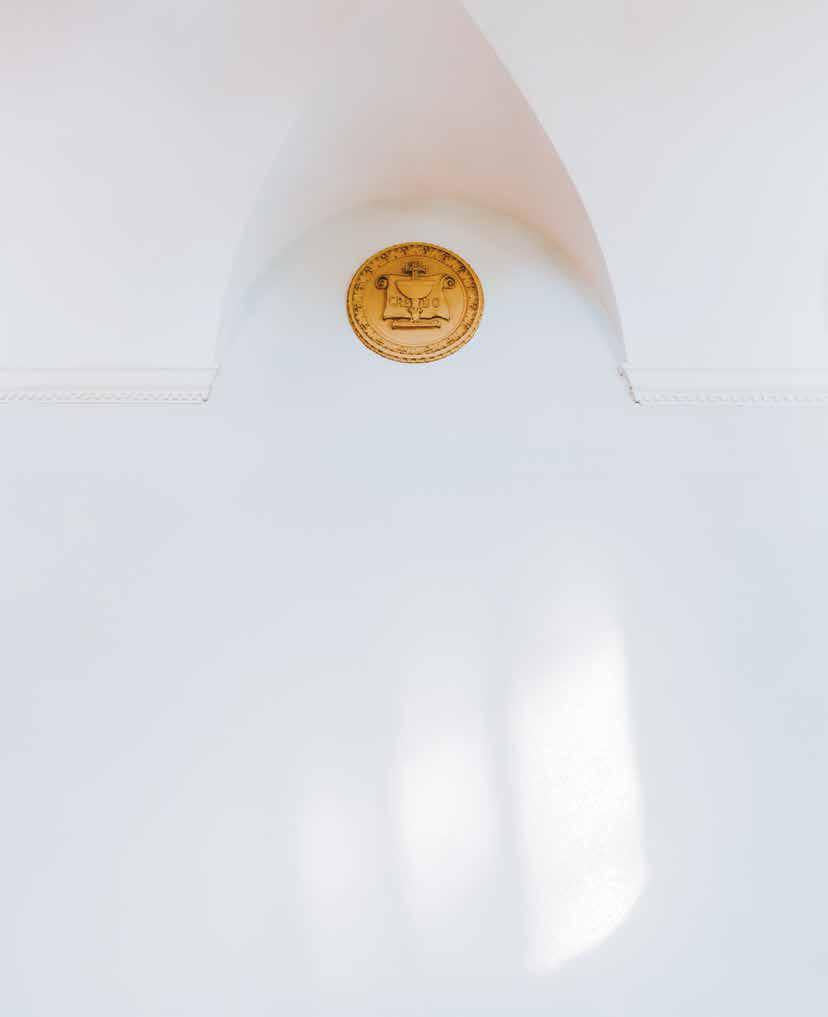
The diaconate is a distinct ministry in the Church, with two forms: transitional and permanent. Transitional deacons are seminarians preparing for the priesthood, serving in this role before priestly ordination. Permanent deacons will remain deacons for life. Many are married and have careers, balancing their ministry with family and professional responsibilities. They assist at Mass, preach, preside over baptisms and weddings and serve their communities through works of charity.

My wife, Laura, and I have been married for 42 years. We both graduated from the University of Dayton and share a love for music and golf.
I began my studies for the diaconate in 2019 through the Lay Ecclesial Ministry Program. In 2022, I continued my formation at Mount St. Mary’s Seminary & School of Theology. It has been a blessing to learn under the guidance of dedicated priests, professors and spiritual advisors as I prepare for ordination in April.
I look forward to serving the St. Gabriel the Archangel Family of Parishes, offering my hands, feet and voice in service to Christ and His Church. I ask for your prayers for my brother deacons and me as we embark on this journey together, that the Holy Spirit may transform our hearts into the Heart of Jesus, allowing us to be His presence in the world.

I was raised in Oklahoma and moved to Cincinnati in 2009. My wife, Stacey, and I have three young adult children—Ryan, Aden and Kalyn. Although I grew up without any formal faith formation, I was baptized into the Catholic Church as an adult at the Easter Vigil Mass in 1998 in Littleton, Colorado. My wife, who was baptized as a child but had not received the other sacraments of initiation, completed them alongside me. Together, we received seven sacraments during that unforgettable Easter Vigil.
I believe my call to the permanent diaconate has been unfolding for quite some time. Upon moving to Cincinnati, I joined a men’s group at Immaculate Heart of Mary and began leading the group after a few years. I then started a similar group at my parish in Hyde Park. During this formative time,
Continued on page 16.
Chris Bergman, continued from page 15.
I witnessed others discerning and being ordained to the diaconate and, in late 2016, began classes at the seminary toward that end. I now recognize this process of discernment as a conversation with God.
Outside of ministry, I enjoy traveling with my wife and taking walks with our dog. I am also a longtime fan of The Chosen, and my wife and I had the privilege of being extras in the Season 3 episode depicting the Feeding of the 5,000.

I have always been close to our Lord. I grew up on a small farm, where it seemed we were always praying for rain. As I grew, got married and raised my family, there were difficult times—challenges with work, health concerns for my children—but time and again, God carried me through. Prayer continually had a positive impact on my family and brought peace to our home. All my life I’ve wondered, If I didn’t have God and family, who would I turn to when times got hard?
Over the years, I’ve worked more than 14 jobs. In one of them, I had a truly great boss, Frederick, a good Christian man who led with integrity. I befriended another admirable Catholic man, Ken, who mentored me in both faith and family life. Although he passed away ten years ago, his influence remains. Now that my children are grown, it’s my turn to mentor others and help lead them to Christ. I hire young men and women to work on the same small farm where I was raised and now guide, encourage and share my faith with them.
In retirement, I knew there was nothing I wanted more than to serve the Lord. In the diaconate program, I have been blessed by the classmates who journeyed alongside me. I can say with complete confidence that Mount St. Mary’s Seminary is rock solid—the faculty is exceptional, and my appreciation for the formation of our priests has only grown.
I grew up in Louisville, Kentucky as the middle of five children in a devout Catholic household. My educational journey took me from Guardian Angels grade school to St. Xavier High School, culminating in a Computer Science engineering degree from the University of Louisville. My wife, Teresa, and I began our life together in 1984, exchanging vows at St. Paul Catholic Church in Louisville. A corporate move brought us to Cincinnati in 1989, where we found our spiritual home at St. Susanna Catholic Church. Our family has flourished here, growing to include seven children and nine grandchildren—truly a testament to God's abundant blessings.

Though my information technology career has been rewarding, teaching has always called to me. As retirement approached, I envisioned teaching in a Catholic school. This led me to pursue studies at Mount St. Mary Seminary to deepen my theological understanding. The journey took an unexpected turn when, after three years of seminary studies, my wife and son Fr. Chris Geiger suggested I consider the permanent diaconate. Through prayerful discernment, I embraced this path. The subsequent three years of diaconal formation have profoundly changed me. I’ve found inspiration in my fellow deacon candidates and been deeply enriched by the scholarly wisdom of the seminary’s priests and instructors.
My commitment to the diaconate stems from a desire to serve God’s people, and I remain receptive to wherever this calling may lead.
I grew up in the suburbs of Chicago and am grateful to my parents for raising me in the Catholic faith. My relationship with Christ and His Church deepened in college at the University of Illinois, where I studied computer science and human factors engineering. It was also there that I met my wife, Denise, to

whom I’ve been happily married for nearly 30 years. Together, we have five adult children.
I first felt the call to the diaconate about 15 years ago. I distinctly remember hearing the Lord’s voice in prayer twice—once during Exposition of the Blessed Sacrament at a retreat and again during Mass at my home church, Our Lady of Good Hope. After much prayer, my wife and I discerned that it was best to wait until our children were grown before pursuing this call further. In 2019, I began my formation in the Lay Pastoral Ministry Program.
One of my most anticipated acts after ordination is celebrating baptisms, as they mark such an important and joyous moment in a person’s life. I also look forward to preaching at Mass. Outside of ministry, I enjoy hiking, camping and traveling to experience the beauty of God’s creation. I love reading and meditating on sacred Scripture, and my favorite prayers are those to the Holy Spirit.

I feel truly blessed to be nearing ordination as a permanent deacon. My wife, Brenda, and I have two children, Renee (married to Dan) and Craig (married to Sarah). We are also blessed with eight wonderful grandchildren. Our eldest grandchild watches over us from heaven, while the remaining seven keep us on our toes with their boundless energy and diverse personalities. In my free time, I enjoy reading, golfing and, most of all, spending time with family and friends.
I grew up in a blue-collar Catholic home, raised by parents whose faith and hard work shaped me. Brenda, my wife of nearly 45 years, has been my greatest source of support and encouragement.
My call to the diaconate began years ago as a quiet, persistent stirring—a sense that God was inviting me to something more. Over the years, I felt a growing desire to serve the Church in a more active way. Through prayer and encouragement from others, I discerned that God was leading me toward the diaconate. A pivotal moment came during a pilgrimage to the Holy Land, when my wife and I visited the Basilica of the Annunciation
in Nazareth. As we reflected on our Blessed Mother Mary’s courageous “Yes” to God, my wife and I decided to look into diaconate formation.
I am deeply grateful for the prayers and support of my pastor, other priests, family, friends and the faithful of the Holy Cross Family of Parishes. I look forward to serving them with joy and dedication.

I was born and raised in Duluth, Minnesota, have two brothers and two sisters and moved to Dayton, Ohio, in 1996. Catholic my entire life, I am grateful to have been raised in the faith by my parents. My wife, Teresa, and I have been blessed with 32 years of marriage and three wonderful sons, all of whom are married.
I am a mechanical engineer and currently serve as the Interim Chair of the Mechanical Engineering Department at Wright State University, where I also teach several courses in the energy field. Additionally, I developed the Renewable and Clean Energy Master’s Degree Program in Engineering, which is now offered at Wright State.
I feel called by God to the permanent diaconate, and my years of study at Mount St. Mary’s Seminary have only deepened this conviction. I hope that I can aid the people of the St. Gabriel the Archangel Family of Parishes (in Dayton, Huber Heights, Vandalia and Tipp City) in their spiritual journeys toward our Heavenly Father. I look forward to assisting at Mass and celebrating baptisms, marriages and funerals. I have a deep love of the Scriptures and hope this love can be shared with the members of those parishes.
Jack Rivetti
I grew up in Greenville, Ohio, and there met my wife, Terri, at church softball. She is a middle school band and orchestra teacher, and I work with individuals who have developmental disabilities. We have three

Continued on page 18.
Jack Rivetti, continued from page 17.
children: Clare, Joseph and Jacob. Shortly after we married, Terri and I moved to Huber Heights in Dayton and joined St. Peter Catholic Church, where we have been parishioners ever since.
My wife and I have always been involved in a number of ministries at St. Peter, prompting my wife to ask me if I had ever considered becoming a deacon. I told her I was interested, but with our children still young, I felt they needed to be my primary focus. As they grew, however, I became increasingly aware that the Lord was calling me to discern a vocation to the diaconate.
I look forward to assisting at Mass as a deacon because I love being close to God, especially in the Eucharist. I also cherish being with people and hope to serve them by bringing Holy Communion, visiting the sick and sharing the faith. One of my greatest joys is studying Scripture, deepening my understanding of how the Old and New Testaments intertwine as part of God’s divine story. A favorite reading is Psalm 63—look it up!
I feel truly blessed to be part of this diaconate group. The men in my class bring great passion and promise for the future of our Church.

I am married to my wonderful wife, Kathryn (McDonough). Growing up in Niles, Ohio, I graduated from Youngstown State University and was commissioned as an officer in the U.S. Army. After nine years in active duty, serving in Germany, the Middle East, Korea and Ft. Carson, Colorado, I served as a Federal Civil Servant in Colorado and Ohio. Outside of ministry, one of my greatest passions is motorcycle riding— it’s exhilarating and freeing.
My mother said I wanted to be a priest—though I can’t remember that. Her reminder led me to discern the diaconate about seven years ago. After much prayer and with the unwavering support of my wife, we said “Yes” to God’s call. Throughout
my formation, I have found deep inspiration in the Psalms, especially those that emphasize gratitude.
I am profoundly grateful for the world-class instructors who have revealed the truth and beauty of the Catholic faith throughout my formation. I eagerly anticipate the joy of sharing this faith with everyone in the archdiocese. I also look forward to helping parishioners discover their individual vocations and the gifts that come from an everdeepening relationship with God.
I am a husband, father and registered nurse with 30 years of experience in pediatrics, both in clinical settings and at home with our nine children. I graduated from Cedarville University with a B.A. in biology and a minor in biblical studies, before going on to earn a nursing degree. My wife and I have been Natural Family Planning (NFP) instructors for over 20 years. During our training, it was the teachings of the Catholic Church—particularly Humanae Vitae—that led us into full communion with the Body of Christ at the Easter Vigil in 2005. Since September 2021, I have served as the Associate Director of Chastity and Natural Family Planning in the Archdiocese of Cincinnati’s Marriage and Family Office.

Before becoming Catholic, I was a deacon in a Baptist church. Through my conversion, the desire to serve remained constant, so I began the educational prerequisites for admission to diaconate candidacy in 2013, trusting that God would guide me if it was His will. My journey toward the diaconate originally stemmed from gratitude for His deliverance and my conversion to Christ at age 19. That gratitude deepened as I experienced the gift of full communion with His Church at age 38.
I look forward to serving as a minister of Eucharistic Exposition, Adoration and Benediction of the Blessed Sacrament. As Jesus said, “Come to me, all you who labor and are burdened, and I will give you rest” (Matt. 11:28).



to Our Newly Ordained Deacons
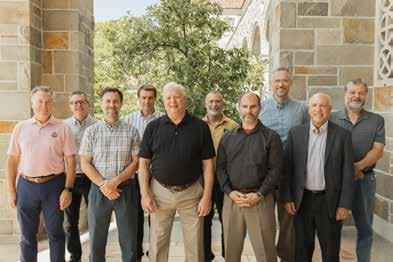
Sacred Hear� Catholic Radio welcomes to the Archdiocese Cincinnati! We look forward to sharing your ministry with our listeners.
Archbishop-designate Casey
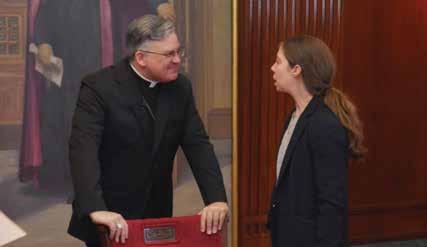
Archbishop-designate Casey and SHR’s Anna Mitchell

On behalf of our local min i stries a nd our e xceptional alumni, the Marianist Pr ovince of the United States congratulates A r c hbishop -designate Robert Casey o n his installation .







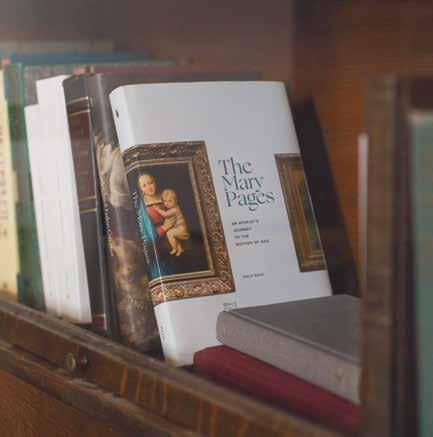
IElizabeth Lev
n an age that questions goodness, scorns chastity and denigrates motherhood, one might wonder how the Virgin Mary, the quiet heroine of the Gospels, could catch the attention of the modern feminist. In The Mary Pages, Sally Read recounts how the Blessed Virgin did exactly that. The Mary Pages reveals the compelling story of a personal conversion. Read’s road is a way of Beauty, wending from a London hospital to the Midwestern plains, to the mountains of Sardinia. The signposts along the road are various images of Mary, all of which reveal the power of the Blessed Virgin to inspire and to heal.
The Mary Pages opens with an invitation to look deeply into Filippo Lippi’s Renaissance masterpiece, The Madonna, Child and Two Angels, discovered in her grandmother’s house. At first, Read confined Lippi’s Madonna with her downcast eyes and silent adoration of her son, to a box under her bed, where it lay dormant during her raucous relationships of younger years. There is an interesting parallel in how the scandalous relationship between Lippi, a Carmelite priest, and his muse Lucretia Buti, a Dominican sister, produced a work of such contemplative loveliness, and how Read’s chaotic love life eventually drew her to the silence of Our Lady.
Read’s journey continues with an acheiropoieton—an image not made by human hands—when she encounters the Madonna of
Guadalupe, as she begins to reject society’s objectification of the female body. Her road leads inexorably to Rome and Michelangelo’s Mary of the Pietà, as the author experiences motherhood. Throughout the book, Mary speaks in many voices, addressing numerous challenges and fears. Sally Read’s courageous intimacy allows the reader to see how these depictions of Mary penetrated her soul and wrought her conversion.
For this art historian, Read’s peregrinations to museums and chapels, where she perceives an ever-increasing call to faith, virtue and conversion, resonate deeply. The Mary Pages, however, is intended for anyone who has been deceived by what Pope Benedict XVI called “illusory beauty,” which, while dazzling, imprisons human beings in their own desires. Instead of lifting up the soul, the false shimmer of facile relationships easily convinces people that beauty is tawdry and love is superficial. The antidote to this spiritual stagnation is authentic beauty, exemplified by Mary, without stain of sin. Read once considered Mary “the embodiment of powerlessness.” But as life wears on, the Blessed Virgin becomes her companion in love, motherhood, loss and change.
What sets Read apart is her honesty, her ability to describe her choices without excuses, and her love for the beauty of words. The Mary Pages shifts gently from narrative to dialogue, from a few lines of verse to dramatic prose. She beckons the reader in myriad forms—solemn, ethereal, joyous, earthy—to a celebration of the woman whose soul magnifies the Lord.
The Mary Pages is an elegant read, meant to be savored, like art. Reading this evocative text, one imagines the Mary of Cana watching over the women of the world, ready to fly to her Son to tell Him that so many of them “have no wine” and to exhort them through gaze, gesture and inspiration: “Do whatever he tells you.”
Elizabeth Lev is a Rome-based art historian. She is the author of several books, including How Catholic Art Saved the Faith and The Silent Knight: A History of St. Joseph as Depicted in Art.
$29.95
The Mary Pages: An Atheist’s Journey to the Mother of God Word on Fire, 2024. | 256 pages

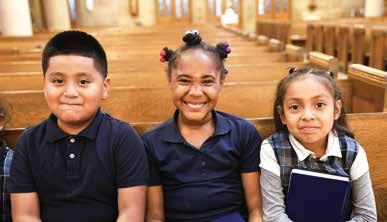
WELCOME!
Archbishop Robert Casey
CISE warmly welcomes Archbishop Robert Casey. We look forward to working with him to further our mission of providing quality, Catholic education to students in Cincinnati’s underserved communities.
Donate Today. Learn More.
CISEKids.org 513.263.3471


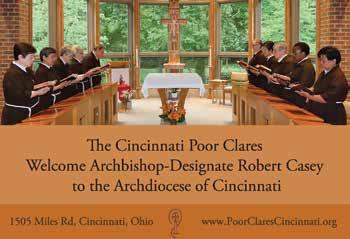

On behalf of the clergy and faithful in the Diocese of Columbus, I wish to extend my heartfelt congratulations to Archbishopdesignate Robert G. Casey, who has been appointed by the Holy Father as the Archbishop of Cincinnati.
THE MOST REVEREND EARL K. FERNANDES
I offer Archbishop Schnurr, Archbishop Casey and the People of God in the Archdiocese of Cincinnati my heartfelt prayers and congratulations.



VIRTUES & VICES | Colin Rahill
In the summer of 2017, I attended a 10-day silent retreat—the first of many, with the longest spanning 33 days. This first retreat introduced me to the unmitigated power of God that comes to us in silence. Vivid dreams filled those ten nights, and long-forgotten memories surfaced in daytime prayer—a common experience among the men at the retreat. There was real spiritual warfare, along with ample material for a comedy sketch. During breaks, we silently wandered the retreat grounds in slow circles, resembling a scene from One Flew Over the Cuckoo’s Nest
An experience on the seventh day changed my life. It was early evening when the retreat leader gave a short talk about Christ on the Cross—how, from the very instrument of His torture,
He prayed for the forgiveness of His executioners: “Father, forgive them, for they know not what they do” (Lk. 23:34).
During the prayer time that followed, I mentally repeated those words again and again. The verse somehow held the secret to all life. A warm twilight settled over the grounds as I walked my usual nightly loop, and a profound grace enveloped me. Though unseen, it felt as if someone of Flesh and Blood walked beside me, as real as any companion. The God of Love was so present, so palpable in those moments that I knew Jesus had drawn near.
On the ninth day, once the sun had set, we were allowed to speak again. But we left the chapel in silence, not yet ready to break it. Then something caught our attention: a rabbit,
right by the chapel door, had given birth. There we stood, nine awestruck men gazing at a bundle of newborn bunnies huddled under a bush. The night deepened and we walked away, still silent, until one of us finally broke the spell. “All right,” he declared, “someone has to be the first one to say something.” We smiled, and from that moment onward, we could not stop talking. Conversation was like food. Under the full moon, we

stayed up the whole night sharing stories, insights and mysteries. In the morning, we exchanged numbers before leaving so we could stay in touch. We never talked again, and that’s exactly how it was supposed to be.
That retreat revealed something to me: silence changes us on a spiritual level. After days without speaking, we didn’t just return to noise; we returned to words that mattered. And that is why, among the fasts you take up as Easter approaches, I encourage you to fast from noise. Noise is the constant hum of our lives—music, podcasts, TV, chatter. We crave it. Silence, however, can intimidate us. It forces us to face the thoughts and emotions we’ve been drowning out.
By framing silence as “noise-fasting,” we begin to see it as a discipline to practice. Consider stepping away from all the noise, even for just 15 minutes a day. Over time, this discipline will take root as a virtue—one that bears fruit in humility, patience and trust.
And if you have the chance, go on a silent retreat. In my experience, something profound always happens. Without fail, I come home a changed man, closer to God.



BY DR. KENNETH CRAYCRAFT


The 1988 film Bull Durham opens with a voiceover by a main character, Annie Savoy, rhapsodizing about the beauty of baseball. “I believe in the church of baseball,” Annie begins, followed by a rather dubious inventory of gurus and other religions she has tried to follow. After a brief soliloquy about the vicissitudes of the game (including a particularly bad trade by the Cincinnati Reds in the 1960s), she concludes, “It’s a long season, and you gotta trust it. I’ve tried ‘em all, I really have, and the only church that truly feeds the soul, day in, day out, is the church of baseball.”
Baseball, of course, is not a religion. And the only Church that feeds the soul is the one, holy, catholic and apostolic Church of Christ. Moreover, we must be cautious about anything that might become an idol in our religious lives or a distraction from the truth of the Catholic faith. Nonetheless, Annie Savoy’s sense of the transcendent tug of baseball rings true for many of us as we anticipate the start of another baseball season in late March.
When an American sports fan refers to “Opening Day,” everyone knows she is talking about the first official day of baseball season. The rhythm of baseball is so ingrained into our national consciousness, we do not need to specify the sport. Other sports have their first weekend or new season’s beginning—their kickoffs, tipoffs and puck drops. But only baseball
has Opening Day. The very phrase instills feelings of hope and optimism. Coinciding as it does with the beginning of Spring and the Easter season, it seems intuitive to associate baseball with joyful rejuvenation. For devout baseball fans, other sports are merely something to do between baseball seasons. Other games have their merits, to be sure, but they don’t communicate baseball’s
sense of transcendent hope. When the cold, dark days of winter are winding down, we turn to baseball to revive our spirits and instill new hope in the months to come.
As Catholics, we affirm the goodness of all creation. We believe that the world is made for our pleasure and our good. Creation is ordered for our benefit, and we are ordered to enjoy its many gifts. Put another way, the good things of creation contribute to the leisure for which we are created. Indeed, we even understand that work is not an end in itself, but rather the means of providing for our well-being, including time and resources for recreational indulgences. In other words, we work so we can rest.
But rest is not equivalent to doing nothing. Rather, it encompasses and incorporates those leisure activities that contribute to a full, rounded and joyful life. For many of us, baseball is just such an activity. The laconic pace of a well-played baseball game gives us time to watch, discuss, debate and digest the action on the field. And like a good story, we can find ourselves in the narrative arc of the game. We sympathize with the batter who hits a scorching line drive directly at the third baseman—“What a bad break!” We identify with the mishit ball that barely clears the shortstop’s glove for a bloop single— “Sometimes I’d rather be lucky than good.” We commiserate with the outfielder who loses a ball in the sun—“It could happen to anyone.” And we admire the resiliency of the players, as they endure (while we enjoy) a very long, 162-game season.
Christ alone nourishes the soul, despite Annie Savoy’s assertion to the contrary. But if properly ordered in an otherwise prudent spiritual diet, baseball can be a healthy snack between meals.
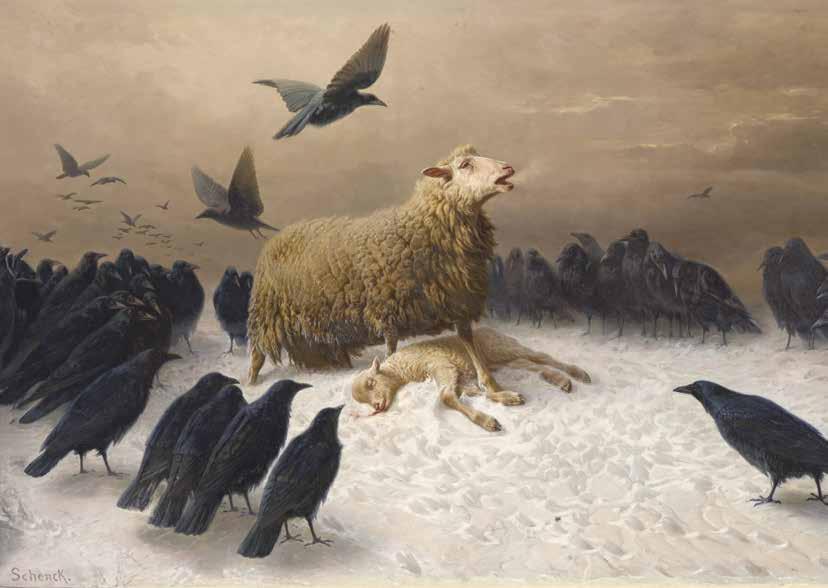
SEEING
| Emma Cassani
In a visually saturated world, it’s easy to feel overwhelmed and become desensitized to beauty. Visio Divina, Latin for “divine seeing,” encourages us to slow down and engage in visual contemplation, using art as a profound tool for connecting with the Divine.
Begin by making the sign of the cross and inviting the Holy Spirit to guide your contemplation. Spend a moment meditating on Anguish, ca. 1878 (Realism period) by August Friedrich Schenck, located at The National Gallery of Victoria, Melbourne.
Born in 1828, Danish painter Schenck moved to Paris to study at the École des Beaux-Arts, and by 1857, he was exhibiting at the prestigious Paris Salon. He excelled at painting landscapes and animals, but many of his works carried a melancholic theme, tackling concepts of death, fear and isolation. He developed a particular interest in painting sheep, often depicting them in dramatic scenes that conveyed deep human emotion. Little is known about his personal life—not even his religious background—yet his paintings express profound Christian themes and symbolism.

Animals have long been used in literature and visual art as metaphors to reflect the human experience and psyche. The 19th century was particularly rich in animal imagery, coinciding with the publication of Charles Darwin’s The Expression of the Emotions in Man and Animals (1872), which explored the idea that animals, much like humans, experience complex emotions and familial bonds. The themes of death, dying and grief were prevalent during the 19th century due to poor sanitation and widespread disease, as well as Queen Victoria’s extended mourning for her husband, Prince Albert.
Wandering a little too far from its mother, a lamb panics, realizing it is alone and in danger. A menacing black bird lands before him, tilting its head as it watches. It lets out a sharp caw, which is soon met with an echoing response. In an instant, a flurry of dark wings descends upon the snow. Terrified, the lamb stumbles backward, bleating for its mother.
Hearing her lamb’s cry, the ewe rushes in fear to find him. She arrives to a horrific scene thrashing wings, pecking beaks and clawing talons. Darkness envelopes her child. With a desperate bleat, she barrels through the swarm of crows, fighting to save her lamb. But it’s too late.
The lamb succumbs, its small body falling limp as blood trickles from its mouth, staining the snow. The ewe cries out in despair, her breath unfurling in the frigid air as she protectively stands over her lifeless child. It is quiet now, except for the soft rustle of feathers. The crows remain still, huddled around their cruel deed, watching and waiting for the ewe to leave so they can feast on their prey.
Schenck’s Anguish is a gut-wrenching image. It can be challenging to look at and uncomfortable to sit with. Yet, this painting has a haunting pull on viewers, stirring deep emotion and unsettling curiosity, evoking a visceral response. Why does this image elicit such a powerful reaction?
Lamb and sheep motifs are prominently seen throughout the Bible. Lambs were often used as sacrificial offerings as atonement
truth does not change according to our ability to stomach it.
for sins, most notably seen in Exodus 12:1-14 and Isaiah 53:7 which point to the Old Covenant. In this painting, even though this lamb was attacked, it appears “without blemish” (echoing Exodus 12) except for the blood dribbling from its mouth.
John the Baptist was the first to refer to Jesus as the Lamb: “Behold, the Lamb of God, who takes away the sins of the world” (Jn. 1:29).
Jesus Himself referred to His disciples as lambs: “Behold, I send you as lambs in the midst of wolves” (Mt. 10:16). But notice how John the Baptist doesn’t just call Jesus a lamb—he calls Him the Lamb of God.
Venerable Fulton Sheen emphasizes this point, “[Jesus] was neither the peoples’ lamb, nor the lamb of the Jews, nor the lamb of any human owner, but the Lamb of God.” Many Centuries earlier, St. Augustine of Hippo questioned, “If to be innocent is to be a lamb, then John was a lamb, for was not he innocent? But who is innocent? To what extent innocent?” The distinction in John’s reference to Jesus is crucial: He is not just any lamb but the Lamb of God. Jesus holds the unique role of sacrificial nature and divine purpose—a role that no other human or lamb could fulfill.
Looking back at Schenck’s painting, it makes sense to interpret the lamb as Jesus and the ewe as Mary, bringing to mind a familiar scene of sorrowful Mother and Child: Michelangelo’s Pieta. This makes the painting feel even more raw
Continued on page 28.


and heartbreaking.
What might the crows represent? In nature, crows are incredibly intelligent creatures. They can recognize faces, mimic voices and sounds, create tools and even leave gifts. They also display a sense of mourning, gathering when one of their own dies in what appears to be a kind of funeral. Despite their whimsical nature, crows are opportunistic omnivores, consuming almost anything—including small animals and sometimes livestock. In Anguish, Schenck captures this stark reality of nature, playing into the ominous term “a murder of crows.”
I interpret the crows as representing the sinful nature of humanity—or, in other words, us. Because of our sins, Christ endured the Cross, offering Himself as the final sacrificial Lamb for our salvation. The crows watching and waiting to eat the lamb is unsettling. However, if we are the crows and Jesus is the sacrificial lamb, then does this not evoke the Eucharist? During the Communion Rite at Mass, the priest raises the host above the chalice reciting, “Behold the Lamb of God, behold Him who takes away the sins of the world. Blessed are those called
to the supper of the Lamb.” The priest’s words echo John the Baptist’s declaration from John 1:29, reaffirming the connection between Christ’s sacrifice and the Eucharist. The Lamb comes full circle here.
Schenck’s Anguish is, in many ways, an Easter painting. At first glance, its cruel imagery may be unsettling, prompting questions like: How can beauty be found in something so horrific? Isn’t Easter about the hope and joy in the Resurrection? While this is true, Flannery O’Connor’s words come to mind: “The truth does not change according to our ability to stomach it.”
We mustn’t forget that Easter’s joy would not exist without the horrific sacrifice that came before it. Artwork like Schenck’s Anguish and depictions of the Crucifixion serve as powerful reminders that Christ’s Passion was both real and necessary. Through them, we can draw deeper into the truth of our salvation, finding hope and joy in the Eucharist—the ultimate fulfillment of the Lamb of God.
For further exploration:
O’Connor, F. (1957). Mystery and Manners: Occasional Prose . Farrar, Straus and Giroux.
Sheen, F. J. (1990). Life of Christ . Doubleday.
CATHOLIC AT HOME | Katie Sciba
Our whole family was on the way to dinner with friends—I was behind the wheel. Andrew rode shotgun, exhausted from work, and our crew almost filled the back of the van.
Almost.
Its eight-passenger occupancy accommodates our family of seven with room for the occasional tag-along. With my oldest approaching 15 and my youngest two months shy of eight, the days of shoe tying and car seat buckling are long over. Much like our current cruise on the highway, the logistics of family life are now smooth sailing.
“Will you do some math for me?” I asked Andrew. Confused, he took out his phone and counted the number of days between two dates I gave him.
“Thirty-three. Why?” I laughed, beaming and waiting for him to catch on. “No way!” he retorted. “You’re not having a baby.”
Those two little lines on my pregnancy test said otherwise. It was very early—I was just four weeks along—but everything was different. That very night we talked about where the baby would sleep, how to rearrange kids’ bedrooms and the fact that we weren’t going to be empty nesters in 10 years like we thought.
We told the kids the news the next day, and, after we convinced them that we weren’t joking, they were over the moon. Life was new. What a thrill knowing a new soul had joined our family—a person who was already changing everything.
Andrew stood in the kitchen stirring dinner. “I like Eleanor,” he said to me. I smiled.
“We’ll call her Nora. Nora Clare.”
Almost as soon as we knew she existed, Nora Clare was gone. The signs were there while I sobbed, praying against the odds
and the reality. I texted the same friends who had shared our happiness just days before, knowing they would be with us in our grief. Their responses have been powerful support as our family continues to cope.
My best friend was at the ready when I told her I miscarried. The way she rallied even acquaintances to bring us dinner was a huge relief. I confess to a tinge of guilt for accepting such generosity. I was physically capable of making dinner myself, but grief overwhelmed me. The friends who supported us this way wanted to do so, and accepting was truly good for my family and me.
We shared our news of life and death with my neighbor down the street. She doesn’t talk much about faith, so her calls and messages telling me she’s praying for us give my heart so much hope. My priest offered up his terrible bout of Influenza A for us. Another friend hugged me and said so sincerely, “I’m praying for you all in my Rosary.” The cloistered nuns who live near me, the Poor Clares, reached out with promises of prayer, too. So many souls talking to the Lord on our behalf, asking for comfort, healing and joy. Above everything else, this is the support my family needs most and what gives me the most consolation.
Among the prayers and pans of lasagna, we also received the gift of empathy. The friends who shared their own stories of miscarriage gave us a new kind of strength. Death touches us all, even while we live.
In time, we’ll have more joy over Nora Clare being with the Lord. Praying for us. Waiting for us to join her. Right now, though, the pain of loss is still very near. Miscarriage is a heartache that is all too common, too vulnerable, and it pierces the heart of a family.
Nora Clare, pray for us. We are praying for you.

Dear friends,
As I drove from Chicago to Cincinnati on the day before the announcement of Archbishop Schnurr’s retirement and my appointment as the next Archbishop of Cincinnati, my thoughts turned toward the journey ahead. I found myself not only considering the immediate journey of the coming weeks, as I would pack up my life in the Windy City and relocate to the Queen City; I thought about the journey we share as disciples on the road of life.
Wherever we may be born and wherever our life takes us, we quickly discover that the gift of life places us in the midst of a community. Our life is connected to the lives of everyone around us, impacting our family of birth, the broader human family, and all of God’s creation. We journey together, pilgrims of hope traveling along the path of life and striving to look to the future “with an open spirit, a trusting heart and far-sighted vision” (Letter of the Holy Father to the President of the Pontifical Council for the Promotion of the New Evangelization, for the Jubilee 2025).
Centuries ago, two disciples of Jesus journeyed together on the road to Emmaus. As they made their way, they found themselves conversing and debating about many things. Their conversation surely included moments of agreement and moments of disagreement and might well have led them to go their separate ways upon arriving in Emmaus. Instead, they found themselves more united through their time together, reaching Emmaus in greater communion with one another. What happened on that journey to assist them in the discovery of true communion?
Their eyes had been opened to discover Jesus in their midst. Recognizing the presence of Christ transformed them. They no longer focused on their own words, speaking at each other with words to convince or cajole. Rather, they focused on the Living Word, the Emmanuel—God with us—calling them into communion and not competition. With the Word of God as their focus, the disciples found
the ability to accompany each other on the way, walking together with Jesus on a journey to greater holiness.
We have been called to that same encounter with Christ, alive and present among us just as He was alive and present to those disciples on the road to Emmaus. Sometimes we may find ourselves like those disciples of old, focused on our own words and firm in our resolve to make our point to those with whom we are speaking. In those moments, we need to set our gaze upon Christ and give the Word of God the ability to speak through us as the source of all we say and do.
Pope Francis, in his message during the Angelus of January 23, 2022, reminds us, “The Word of God is also the beacon that guides the synodal journey that has begun throughout the Church. As we strive to listen to each other with attention and discernment—because it is not about conducting an inquiry on opinions, no, but about discerning the Word, there—let us listen together to the Word of God and to the Holy Spirit.”
As I begin my journey with you in the Archdiocese of Cincinnati, I look forward to discovering together the presence of Christ in our midst. With Christ to instruct and guide, I hope that we can help one another to view the world around us in the Light of Christ and experience together the blessing of being one with God and one with neighbor. With the Word of God as our inspiration and the Divine Light of Christ as our beacon, we will find our way, each step leading us out of the darkness of sin and division and into the light of reconciliation. With the assistance of God’s saints and angels, who intercede for us, I look forward to walking with you and sharing the peace, love and joy that has been offered to us through the death and resurrection of Jesus Christ.
Sincerely yours in Christ, Archbishop
Robert G. Casey
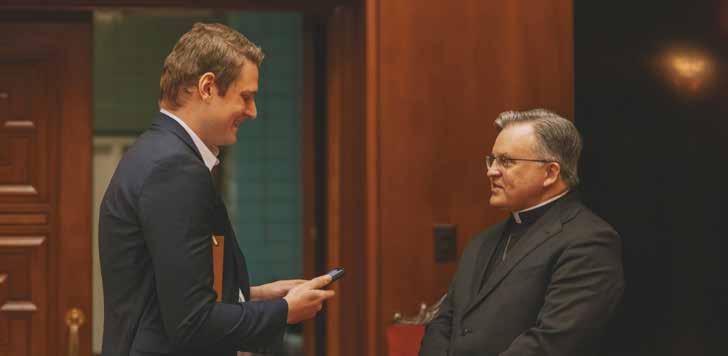
ARCHBISHOP-DESIGNATE ROBERT G. CASEY
Colin Rahill
At the break of dawn on Wednesday, February 12, the faithful of the Archdiocese of Cincinnati awoke to historic news: Pope Francis had accepted Archbishop Dennis M. Schnurr’s resignation and appointed his successor—Most Reverend Robert G. Casey, Auxiliary Bishop of Chicago. Just hours later, Archbishop-designate Casey stood before the press in the basement of the Cathedral Basilica of St. Peter in Chains and introduced himself to the people he would soon shepherd.
Following the press conference, Archbishop-designate Casey spoke with The Catholic Telegraph on topics beyond his public remarks, including his experience walking the Camino and his passion for long-distance running, the latter helping him to stay grounded amid stress.
Crediting his family’s strong faith as the foundation for his Catholic identity, Archbishop-designate Casey fondly recalled visiting his grandparents.
“We would go to my grandparent’s farm in Michigan, and we’d go to church with everybody—aunts, uncles, cousins,” he said.
He particularly remembers a cherished Sunday tradition: “I oftentimes say that at my grandparents’ church in Michigan, they had a doughnut ministry. Every Sunday, they made fresh doughnuts in the gym of the school. And so, you’d go to Mass and you could smell the amazing doughnuts.”
Laughing, he added, “I always joke that I came to Jesus by way of doughnuts.”
When asked about experiences that shaped his approach to ministry, Archbishop-designate Casey shared that, in 2003, he undertook a solo 40-day “Camino” pilgrimage to Santiago de Compostela in Spain.
“A significant discipleship moment of encounter was on the Camino in Spain. Walking that Camino changed me, both as
a disciple and as a priest. I came back renewed in my discipleship and renewed as a priest.”
Although he traveled alone, he never felt isolated.
“I went alone, but I never was alone on the Camino. I became a friend to this very diverse population,” he said. “That, to me, was one of those life-defining moments—walking 500 miles, experiencing the intercession of the Blessed Virgin Mary, the intercession of Saint James the Pilgrim and the joy of Church. It was transformative.”
Appointed auxiliary bishop in 2018, Archbishop-designate Casey is no stranger to the pressure of pastoral leadership. His remedy: prayer and long-distance running.
“I’m trying to re-engage my joy of running,” he said. “A friend has convinced me to sign up for a marathon at the end of October. So, if I can develop that discipline again—that’s something that is not only a physical benefit, but emotional and spiritual as well.”
Reflecting on the moment he first learned he would be the next Archbishop of Cincinnati, Archbishop-designate Casey expressed profound gratitude.
“I wanted to say to Jesus, ‘Me? Really?’ And then, I can’t help but say yes because I look back on my journey—He’s always had my back. So how can I not trust Him? The only word I have is ‘gratitude,’ and it comes from this abiding faith in Christ Jesus. … First and foremost, gratitude to Jesus, and secondly to Pope Francis and Cardinal Cupich. What a great adventure this is!”
Archbishop Dennis M. Schnurr congratulated Archbishopdesignate Casey on his appointment.
“It has been my great honor and privilege to serve the people of the Archdiocese of Cincinnati these past 15 years. Now, on behalf of the people of the Archdiocese of Cincinnati, it is a great joy to welcome Archbishop-designate Robert Casey to his new home,” Archbishop Schnurr said. “Archbishop-designate Casey is highly regarded by the people and priests he serves, and I am pleased such a good man will be shepherding the people of the Archdiocese of Cincinnati.”
Let us all join together in expressing our heartfelt gratitude to Archbishop Schnurr and extend our prayers and congratulations to Archbishop-designate Robert G. Casey.




Bishop John Iffert together with Bishop Emeritus Roger J Foys and the Priests, Deacons, Religious and Lay Faithful of the Diocese of Covington
Send prayerful best wishes to welcome
Archbishop-designate Robert G Casey and
ARCHBISHOP-DESIGNATE'S BIOGRAPHY
Rebekah Davidson
The Archdiocese of Cincinnati is welcoming Most Reverend Robert Gerald Casey, currently Auxiliary Bishop of Chicago, as its 11th bishop and 10th Metropolitan Archbishop. Pope Francis announced the appointment on February 12, 2025, after accepting the resignation of Archbishop Dennis M. Schnurr, who has held the position since 2009. A priest for more than 30 years, Archbishop-designate Casey has served in multiple pastoral and leadership roles.
Born on September 23, 1967, Casey is the son of Michael A. Casey, a meat cutter from County Wicklow, Ireland, and Margaret A. Carmody Casey, a registered nurse from southwest Michigan. The fourth of five children (two brothers and two sisters) raised in the village of Alsip of the Chicago Metropolitan Area, he said he has “been blessed with a wonderful family” and received much encouragement from his parents and grandparents in pursuing his vocation (Profiles in Catholicism, Dec. 10, 2018).
Raised in the faith, Casey was an altar server in his childhood at St. Terrence Parish. A product of public elementary schools, he continued his Catholic education at Marist High School, graduating in 1985. The diocesan newspaper Chicago Catholic reported that, while in high school, he helped found his parish’s teen club and assisted with teaching CCD classes. His junior year, Casey interviewed his parish priest for a religion class assignment. During this interview, his pastor asked Casey if he had considered a vocation to the priesthood. His
answer at the time was “No,” but the encounter sparked his discernment process.
While on retreat the following year, Casey revealed to his parents in a letter that he may have a call to the priesthood, which did not surprise his family. He continued to discern this call while attending Niles College Seminary of Loyola University Chicago, where he earned a bachelor’s degree in English in 1989.
The following year, Casey entered Mundelein Seminary in the Archdiocese of Chicago and earned a Master of Divinity degree in 1994. While ministering to the archdiocese’s Hispanic community as a seminarian, he became fluent in Spanish. He grew to love the Hispanic people and their culture, which influenced his pastoral ministry and fostered a deep devotion to Our Lady of Guadalupe. The Oblate Sisters of Jesus the Priest, founded in Mexico, also significantly influenced and strengthened his vocation during these years.
On May 21, 1994, Casey was ordained a priest for the Archdiocese of Chicago by Cardinal Joseph Bernardin at Holy Name Cathedral. His first assignment was as associate pastor of St. Ita Parish in Chicago, where he remained until 1999. In 1998, Casey was named the associate director of Casa Jesus, a priestly discernment program for Hispanic men, and became its full-time director in 1999.
After completing his work with Casa Jesus in 2003, Casey
seized the opportunity to embark on a 40-day pilgrimage walking the Camino de Santiago in Spain. He described his experience as “life-changing” and felt his call to discipleship strengthen. Upon returning from Spain, Casey served as pastor of Our Lady of Tepeyac Parish in Chicago.
With sponsorship from the Congregation of the Sisters of St. Joseph, in 2008, Casey co-founded Taller de José, a non-profit organization that offers companionship to those in need and connects them to social service resources.
He was appointed pastor at St. Barbara Parish in Brookfield, Illinois, in 2009, then pastor of St. Bede the Venerable Parish in Chicago in 2016. While here, Casey served on the archdiocese’s priest placement board and the priest steering committee for Renew My Church, an initiative led by Cardinal Cupich to revitalize the archdiocese. This project included restructuring parishes in a process similar to that of the Archdiocese of Cincinnati’s Beacons of Light.
In 2018, Casey was appointed auxiliary bishop of Chicago and Vicar for Vicariate III, overseeing approximately 60 of the archdioceses parishes. He was ordained a bishop by his Eminence Blase J. Cupich, Cardinal Archbishop of Chicago. He began serving as the Vicar General in 2020, a position he maintains until his installation as the Archbishop of the Archdiocese of Cincinnati.
In his spare time, Archbishop-designate Casey enjoys longdistance running and completed five marathons in his forties between 2012 and 2018. With a friend’s encouragement, Casey is stepping back in for a marathon this October, at age 58.
In a press conference following the announcement of his new role as the Archbishop of Cincinnati, Casey provided his insight on current issues. Regarding immigration, he emphasized the need to uphold the human dignity of our immigrant brothers and sisters while practicing faithful citizenship for the common good. Echoing the Holy Father’s call to synodality, he accented the need for our Church to build bridges, to dialog and to listen.
In Archbishop-designate Casey’s episcopal motto, “Into Your Hands,” we hear the words of Jesus from the cross. These words first resonated with Casey as a young seminarian, trusting in God’s plan for his life, and they remain with him as he begins his ministry as archbishop in the Archdiocese of Cincinnati. They are the same words prayed every night by the faithful across the globe as part of the breviary prayers: “Into your hands, Lord, I commend my spirit.”
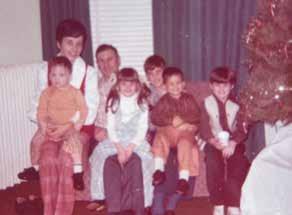




The left side of the shield displays the Archdiocese of Cincinnati’s coat of arms (or simply “arms”). The plow alludes to the Roman hero Cincinnatus, who was plowing his field when an embassy from the Senate called him to accept the dictatorship. He left his plow in the field, restored order to the Republic, resigned his office and returned to finish plowing his field. George Washington and his officers took Cincinnatus as a model of public service without ambition, and after the Revolution, they formed the Society of the Cincinnati. General Arthur St. Clair, first governor of the Northwest Territory and a member of the Society of Cincinnati, changed the name of the settlement on the Ohio River from Losantiville to Cincinnati. The budded crosses, each with a sharpened foot, represent the planting of the faith in the Old Northwest. The colors red and gold are associated with Saint Peter, the patron of the archdiocesan cathedral.

with the chevron, allude to the arms of the Casey and Carmody families, his Irish heritage. The shell and stars commemorate his pilgrimage to the shrine of Saint James at Compostela (Campus Stellae, “Star Field”), and the scallop shell of Saint James the Pilgrim depicts an open hand, ready to both give and receive. The six stars represent important influences in the archbishopdesignate’s life: first his parents and four siblings, then the six parishes which formed him on his journey to becoming a bishop.
Inscribed below the shield is Archbishop Casey’s motto: “Into Your hands” (Luke 23:46). This phrase, part of the last sentence Jesus spoke on the Cross and now prayed nightly by the Church at compline, reminds us that all we are and all we do becomes efficacious and gracefilled when we surrender to God’s will, walk with Jesus and place our trust in the Holy Spirit.
The shield’s right side displays Archbishop-designate Casey’s personal arms. The white and red colors, along
The cross with two crossbars and the green pontifical hat with twenty tassels arranged to either side of the shield indicate that these are the arms of a Roman Catholic archbishop.
Archbishop-designate Casey’s coat of arms was drawn by Father Dohrman Byers. Father Byers created Archbishop Schnurr’s arms and the arms of Saint Peter in Chains Cathedral when it was designated a minor basilica. He has designed coats of arms for several bishops, priests, and parishes. He is a member of the American Heraldry Society.
Archbishop-designate Casey’s coat of arms was drawn by Father Dohrman Byers. Father Byers created Archbishop Schnurr’s arms and the arms of the Cathedral Basilica of Saint Peter in Chains when it was designated a minor basilica. He has designed coats of arms for several bishops, priests and parishes. He is a member of the American Heraldry Society.

With praise and thanksgiving to Almighty God the Church of the Archdiocese of Cincinnati
joyfully announces the MASS OF INSTALLATION of
HIS EXCELLENCY
as the Eleventh Bishop and Tenth Metropolitan Archbishop of Cincinnati in the presence of HIS EMINENCE
CHRISTOPHE CARDINAL PIERRE
Apostolic Nuncio to the United States of America
Thursday, the third day of April
Two thousand and Twenty-Five At two o’clock in the afternoon
Cathedral Basilica of St. Peter in Chains 325 W. Eighth Street, Cincinnati, Ohio 45202
Attendance at the Mass is by invitation only. View the livestream of the Mass at www.catholicaoc.org
Soon-to-be Saint Carlo Acutis wrote, “The more often we receive the Eucharist, the more we become like Jesus and the more we get a foretaste of Heaven.” As Catholics we often forget that Holy Communion is not merely one of the many rituals of the Mass: it is the moment we have been waiting for. When Mass begins, we start at the foot of Calvary’s hill, confessing our sinfulness and our need for a savior. From there, we make our way to the top of the hill to receive what Vatican II called “the source and summit of the whole Christian life,” the gift Jesus makes of Himself upon the Cross: the gift promised at the Last Supper when He said, “This is my Body … given up for you … This is my Blood ... poured out for many” (Mt. 26:26-30)
We come to Mass not only to pray, worship and give thanks, but to enter into Holy Communion with Jesus Christ Himself, to participate in the mystery of Jesus the Bridegroom and His Bride, the Church, where in Holy Communion the two become one. We cannot approach this heavenly moment casually; we must come prepared, having examined ourselves and our relationship with Him: are we one with Him in heart and soul as we soon will be in sacrament?
If we have turned away from Him in mortal sin, we must abstain from Communion. As St. Paul reminds the Corinthians, “For anyone who eats and drinks without discerning the body, eats and drinks judgment on himself” (1 Cor. 11:34). How can we enter into
Communion with Jesus if, in our sin, we have rejected Him? Consider a friendship and the effect a betrayal or an act of violence can have on the intimacy one shares; if this is true of our human friends, how much more so Jesus? Holy Communion is unity with Jesus—hence “communion”—and if mortal sin breaks our bond with Him, we must reconcile with God before we receive Holy Communion again. As part of our preparation for Mass, we must take the time to examine our hearts and souls: Am I ready to be one with Jesus in Holy Communion today?
We further prepare for Holy Communion by fasting for one hour prior to receiving the Eucharist. Fasting is a holy activity practiced even by Our Lord. It helps prepare us to receive this special and holy Food: the Body and Blood of Jesus Christ. We begin to prepare our hearts and minds for this sacred time, as well as prepare our bodies, witnessing by this simple act the truth that “Man does not live by bread alone” (Deuteronomy 8:3). This little fast allows us to turn away from the things of this world to instead turn body and soul toward the Lord who says, “I am the bread of life; whoever comes to me will never hunger, and whoever believes in me will never thirst” (Jn. 6:35).
Having prepared for Holy Communion in our hearts and our bodies, when the time comes, how ought we
Continued on page 40.
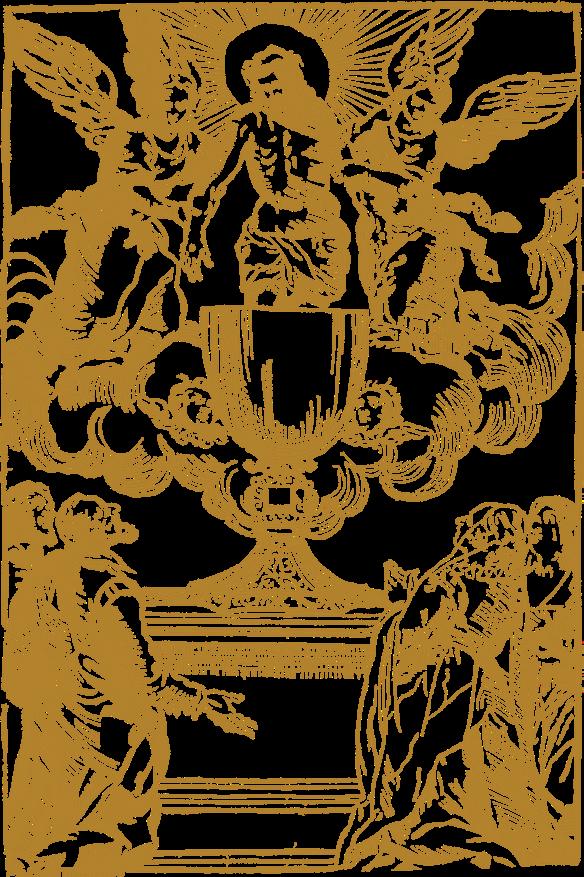
is a gift we receive , not something we are owed.
receive Him? The Church allows us to receive in the hand or upon the tongue, whichever the communicant prefers. When receiving in the hand, do not take the Host from the minister; let the minister give the Host to you. The Eucharist is a gift we receive, not something we are owed or may take. Do we not pray shortly before Holy Communion the humble prayer of the Centurion, “Lord, I am not worthy that you should enter under my roof” (Mt. 8:8)?
This is why we receive in a humble manner, like children being fed or as beggars with hands outstretched. However we choose to receive, we must do so with all humility and care, for as St. Thérèse of Lisieux wrote in her autobiography: “Our Lord does not come from Heaven every day to stay in a golden ciborium; He comes to find another heaven, the heaven of our soul in which He loves to dwell.”
How blessed are we that Jesus, so eager to enjoy communion with us in the life to come, has gone through such extraordinary means to make that communion possible in this life, while we are yet in the midst of our struggle with sin. During this time of Eucharistic Renewal, let us all renew our efforts to deepen our gratitude for this gift, and to do what we can to approach Holy Communion with the care, reverence and love He deserves, because—upon the Cross and again in the Sacrament—He showed us such care, reverence and love first (1 Jn. 4:19).
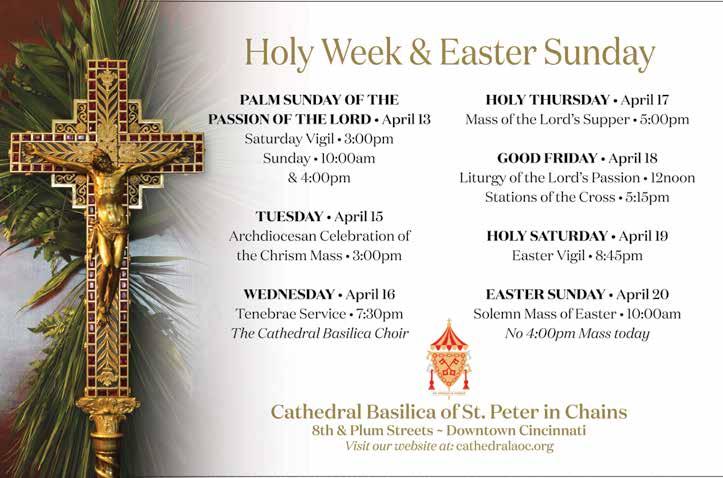

Eileen Connelly, OSU
A cathedral is the home church for the bishop or archbishop of a Catholic diocese. Ten bishops have served Catholics in the Archdiocese of Cincinnati, and their ministry is intertwined with the history of the Cathedral Basilica of St. Peter in Chains. This is part two of those archbishops’ histories. Part one is found in the March issue of The Catholic Telegraph.
Born August 18, 1885, Karl J. Alter was ordained to the priesthood for his native diocese of Toledo in 1910 and appointed its bishop in 1931, where he served 19 years until being named Archbishop of Cincinnati in 1950.
He began and oversaw the restoration of St. Peter in Chains Cathedral, declaring, “We are going home in 1951.” He also supervised St. Gregory Seminary’s completion and about 130 other major building projects. Notable events at the cathedral during his tenure include a citywide memorial service to honor President John F. Kennedy, on December 22, 1963, and an interfaith memorial service for Dr. Martin Luther King Jr., on April 11, 1968.
named Auxiliary Bishop of Cincinnati, and named Bishop of Evansville eight years later.
In 1969, he returned to the diocese as Archbishop of Cincinnati and was known for his warmth and approachability. He launched the Sixth Archdiocesan Synod, involved laity in more decision-making and was devoted to ecumenism. He was archbishop when a pontifical Mass celebrated the Archdiocese of Cincinnati’s 150th anniversary, with apostolic delegate Archbishop Luigi Raimondi as the primary celebrant.
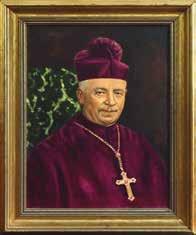
Responsible for implementing Vatican II reforms in the Archdiocese of Cincinnati, Archbishop Alter inaugurated the use of English during his celebration of the Mass at the cathedral on November 29, 1964, which aired live on local television stations.
Archbishop Alter retired in 1969, but maintained an active and visible ministerial role in archdiocesan life until his death August 23, 1977.
Paul F. Leibold was born in Dayton on December 22, 1914, and graduated from Chaminade High School, then the University of Dayton, before his ordination to the priesthood on May 18, 1940.
Father Leibold served as chancellor of the Archdiocese of Cincinnati and as pastor of St. Louis Church. In 1958, he was
Archbishop Leibold died suddenly on June 1, 1972, at the age of 57.
Joseph L. Bernardin was born in Columbia, SC, on April 2, 1928. Following studies at Mount St. Mary Seminary in Maryland, he was ordained in 1952 for the Diocese of Charleston and served as a parish priest and chancellor before being named Auxiliary Bishop of Atlanta.
Upon his appointment to lead the Archdiocese of Cincinnati in 1972, Archbishop Bernardin became the youngest archbishop in the United States. During his decade of tenure, he was president of the then National Conference of Catholic Bishops, from 1974 to 1977, and appointed four times (1974, 1977, 1980 and 1983) by his fellow bishops as one of four American delegates to the World Synod of Bishops in Rome.
In June 1974, St. Teresa of Calcutta was presented with the Peace Award of the North American Federation of the Third Order of St. Francis at St. Peter in Chains Cathedral. A year later at the same cathedral, Archbishop Bernardin reconsecrated the archdiocese to the Immaculate Heart of Mary during a solemn Mass. He celebrated the United States’ bicentennial during a pontifical Mass in July 1976. In September 1976, Pope St. John Paul II, while serving as Cardinal Archbishop of Krakow, visited the cathedral.
Cardinal Bernardin was appointed Archbishop of Chicago in 1982 and elevated to the rank of cardinal the following year. After a public and courageous battle with cancer, he died November 14, 1996, in Chicago.
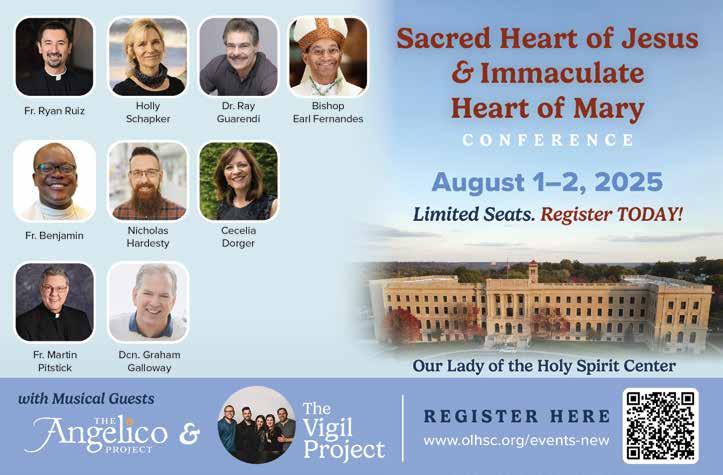

CATHOLIC CHARITIES SOUTHWESTERN OHIO moved nearly 22,000 people from crisis to stability and self-sufficiency in 2024.
We do so by providing a wide range of local services that help families thrive, including senior and caregiver support, mental health counseling, family and parenting education, migrant and refugee assistance, and much more.
To learn more about the programs and the other works of mercy Catholic Charities provides, visit our website at ccswoh.org.
Interested in supporting the Catholic Charities’ programs? Donate securely online at ccswoh.org or mail in your donation.




John Stegeman

Walking where Jesus walked is a life-changing experience. As a pilgrimage to the Holy Land may not be possible for many, two seasonal exhibits at the Holy Spirit Center in Norwood bring the experience close to home.
Through immersive displays with meticulously designed sets, lighting, music and—during the Advent season—volunteer actors who bring the streets to life, you can experience the Holy Land while meditating on the mysteries of the Rosary. During Advent, you’re invited to “The Joyful Mysteries and Walk through Bethlehem” exhibit, and in Lent, to the “The Sorrowful Mysteries and Stations of the Cross in Jerusalem” exhibit, the latter remaining open through October.
“We’ve been wanting to do something like this for years,” said Andrea Pferdmenges, who organized the project with two other volunteers, her sister Christy Rieder and Scott Froendhoff.
For years, the Holy Spirit Center has marked Christmas in a special way, like with the 16-foot Star of Bethlehem atop the
90-foot bell tower. The immersive Bethlehem and Jerusalem exhibits grew from that tradition, expanding the center’s commitment to bringing the story of Christ to life.
“It’s amazing how it all came together,” said Dan Green, the center’s director.
Rieder and her sister became involved at the Holy Spirit Center in 2020 when Rieder sought an open Catholic gift shop during the COVID-19 pandemic; she found one there. Her conversation with an employee led to her signing up for a volunteer opportunity, prompting Pferdmenges to enlist as well. The sisters were inspired by a Protestant church’s “Back to Bethlehem” event and, with Green’s blessing, they launched the “Streets of Bethlehem” exhibit in 2022, which first took shape in a hallway on the main floor.
“We felt called to do this,” Pferdmenges said. “We’d never seen anything that truly transports people back to Bethlehem—to the original story, to the birth of Christ.”
After the initial exhibit ended, it was moved to a permanent space in the center’s basement, the former site of the seminary’s bowling alley.
Once planning for the permanent location commenced, Froendhoff stepped up to help. Though previously part of a prayer group at the center, he hadn’t visited in years. On a fateful visit back one morning, he met Judy Zarick, the center’s Director of Development & Communications. When he mentioned his experience in set design for high school theater, she introduced him to Pferdmenges, and he joined the project.
The streets of Jerusalem exhibit first appeared in 2024, enabling visitors to walk through a re-creation of a Jerusalem marketplace, journeying with the Stations of the Cross along the way. The exhibit is punctuated by many paintings from Cincinnati artist Holly Schapker.
“The Jerusalem exhibit is so powerful,” Froendhoff said. “It’s very spiritual. You feel like you’re literally walking through the marketplace like Jesus had to do, carrying his cross.”
Pferdmenges emphasized its prayerful nature.
“It’s not just Stations on the wall. This is the backdrop of His life and what He really went through.”
All three volunteers credit the Holy Spirit for inspiration and for bringing these exhibits to life. Their prayerful approach includes time spent in the Holy Spirit Center’s perpetual adoration chapel before brainstorming each next phase.
“This is no kudos to myself, no kudos to my sister or Scott,” Rieder said. “It is above us. It’s everybody who has ever volunteered there,” from the building’s opening through the 10 years it sat vacant. Rieder added, “There’s no pride in this project. There’s love in this project.”
“The Sorrowful Mysteries and Stations of the Cross in Jerusalem” exhibit is open now, to all ages. The experience is free, although donations are encouraged. To schedule a visit, call the Holy Spirit Center at (513) 351-9800.
St. Gertrude Parish and the Dominican community of friars and sisters
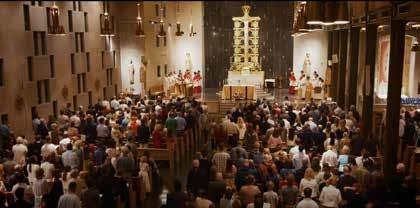


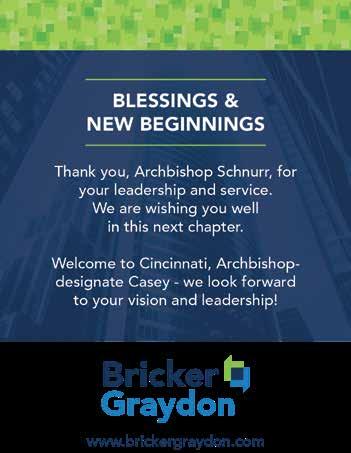

8815 East Kemper Rd., Cincinnati, OH 45249 (513) 489-8815
• vigil: 8:45 pm (Regular Saturday 4 p.m. Mass will not take place.)
• sunday mass: Church • 8 a.m., 10 a.m., & 11:30 a.m. Community room • 10 a.m. & 11:30 a.m.
st. martin of Tours | 3720 St. Martins Pl., Cincinnati, OH
• Vigil: 8:45 p.m.
• Sunday Mass: 9 a.m.
our lady of lourdes | 3426 Lumardo Ave., Cincinnati, OH
• Sunday Mass: 10 a.m.
st. aloysius gonzaga | 4366 Bridgetown Rd., Cincinnati, OH
• Sunday Mass: 9 a.m. & 11 a.m.
• vigil: 8:45 p.m. | St. John the Baptist Church, 5361 Dry Ridge Rd., Cincinnati, OH
• sunday mass: 10:45 a.m. | Corpus Christi | 2014 Springdale Rd., Cincinnati, OH
• sunday mass: 8:30 a.m. & 11
a.m. | St. John the Baptist, Dry Ridge – 5361 Dry Ridge Rd., Cincinnati, OH
• sunday mass: 8:45 a.m. | St. John Neumann – 12191 Mill Rd., Cincinnati, OH
894 Oakland Rd., Loveland, OH (513) 683-0105 vigil: 8:30 p.m.
sunday mass: 8 a.m., 10 a.m., & 12 p.m.

140 S. Findlay St., Dayton, OH daytonlatinmass.org
holy Thursday: 7 p.m.
• good friday: 3 p.m.
• easter vigil: 10:30 p.m.
• easter sunday: 8 a.m. (Low Mass) 10:30 a.m. (High Mass)







It is such a joy to offer to Archbishopdesignate Robert Casey, on the occasion of his installation as the 11th archbishop of Cincinnati, the heartfelt congratulations and prayers of the laypeople, deacons, priests and bishops of the Archdiocese of Chicago.
May the Lord richly bless your episcopal ministry, Archbishop-designate Casey, and all those entrusted to your care.
— Cardinal Blase J. Cupich


The Diocese of Marquette offers prayerful best wishes to Archbishop Schnurr and a warm welcome to Archbishop-designate Casey

from Bishop John Doerfler, Bishop Emeritus James Garland (Auxiliary Bishop of Cincinnati 1984-1992), clergy, religious and faithful of the Diocese of Marquette.

Kary Ellen Berger
The pain of regret can be crippling. But the Church offers a message of hope: nothing is beyond God’s mercy.
As we near the conclusion of the Year of Mission within the National Eucharistic Revival, we are reminded that the Eucharist is not just a celebration. It’s an invitation—to healing, to renewal, to a deeper encounter with Christ. Project Rachel embraces this mission by extending God’s love and forgiveness to those suffering from the wounds of abortion. Through prayer and sacramental grace, this ministry reminds us that no burden is too heavy for the One who gave Himself entirely for us.
Project Rachel is a confidential Catholic ministry offering hope and healing to those affected by abortion. Through spiritual counseling, advocacy and peer support, women and men experience God’s grace. Natalie felt this grace when she first learned of Project Rachel. She said that after her abortion, “Every day I would relive my abortion from the moment I woke up until the moment I went to bed. My life had been taken over by the idea that I didn’t deserve anything good and that anything bad that happened was punishment for what I had done.”
When she passed a Catholic church while walking one day, Natalie felt compelled to go inside. Soon after, she signed up for OCIA classes and began welcoming God into her life. A priest connected her with Project
Rachel, where she now walks with mothers in difficult situations, speaks to men and women affected by abortion and shares her story with others.
“Since Project Rachel, I have experienced that God wants me,” said Natalie. “All of me—even the parts that I want to hide. Knowing that He loves me that deeply and entirely, I am in awe that He would give Himself for me, especially in the Eucharist. He allows me to receive Him into myself, even after I have committed such a terrible sin. He wants to be in it with me.”
Natalie describes Project Rachel as a place where she can share her deepest thoughts and be met with love and understanding. More than just a support group, Project Rachel is a reflection of God’s mercy, revealing His presence in every conversation.
“We all fall,” said Natalie. “[However], through the grace of God and through Him in the Eucharist, we are able to live a life of gratitude, bringing the love of God to those around us.”
Natalie continued, “I hope people see that there is no such thing as ‘too far gone.’ God desires each of us and He can and does use everything we go through to bring us closer to Him. There are people who don’t even know you, but who care about you and want to make sure you know how loved you are. Lastly, but certainly not least, there is no sin too great or grave for God. He is not scandalized by us.”



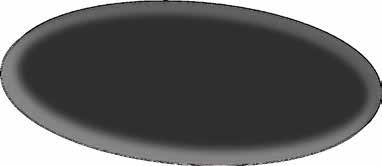



CHRISTIAN ANTHROPOLOGY | Andrew J. Sodergren, M.T.S., Psy.D.
Note: This article is part of an ongoing series on Pope St. John Paul II’s “Theology of the Body.”
In his reflections on “eschatological man” (i.e., the human person in light of our ultimate destiny with God in the resurrection of the body and the new creation), Pope St. John Paul II meditated deeply on our Lord’s teaching that “those who are accounted worthy to attain to that age and to the resurrection from the dead neither marry nor are given in marriage” (Lk. 20:35). As we have explored this teaching the last few months, we have seen that our beatific union with God will completely fulfill all our longings for love and communion. We will be fully permeated by God—body and soul—and participate in the inner exchange of love at the very heart of the Blessed Trinity. We will also experience the most profound communion with all other human persons who have similarly attained eternal life. As a result, earthly marriage, by which we belong to another in an exclusive way, no longer makes sense. This led Pope St. John Paul II to a startling conclusion: in
the resurrection, “the virginal state of the body will manifest itself… as the fulfillment of the spousal meaning of the body” (TOB 68.3).
Our deepest fulfillment as persons is to freely become a self-gift to others.
Unpacking this connection between the spousal meaning of the body and virginity led Pope John Paul to meditate on “continence for the kingdom of heaven.” This refers to those states of life in the Church in which a man or woman voluntarily renounces earthly marriage and takes a vow of virginity or celibacy. John Paul II saw an essential link between marriage and continence for the kingdom. In his 1981 exhortation on the Christian family, he wrote:
“As an incarnate spirit, that is a soul which expresses itself in a body and a body informed by an immortal spirit, man is called to love in his unified totality. Love includes the human body, and the body is made a sharer in spiritual love. Christian revelation recognizes two specific ways of realizing the vocation of the human person in its entirety, to love: marriage and virginity or celibacy. Either one is, in its own proper form, an actuation of the most profound truth of man, of his being ‘created in the image of God’” (no. 11).

In this passage, we see a clear expression of the late pope’s understanding of the vocation to love, i.e., the fundamental vocation of every human being is to make a total gift of self. This vocation flows from our being made in the image of God who is Love—Father, Son, and Holy Spirit. Furthermore, our very existence is a pure gift from God. This “giftness” structures our entire being and essence such that our deepest fulfillment as persons is to freely become a self-gift to others. While we can make a gift of self to others in innumerable ways, the most complete form is to make a total gift of self by which we belong to another in an exclusive and permanent way. St. John Paul taught that there are two states of life in the Church that embody this total gift of self: marriage and continence for the kingdom.
Both marriage and continence for the kingdom fulfill the spousal meaning of the body, which refers to the call and capacity of the human person to make a total gift of himself in love. In Christian marriage, men and women make a total gift of self through their nuptial vows to one another in Christ. In various forms of consecrated life, men and women freely take vows or promises to Christ by which they renounce earthly marriage so as to make “an exclusive gift of self to God” (TOB 73.1), thereby following Christ more closely and dedicating themselves more exclusively to the building of the Kingdom of God. In this state, “the human being is awaiting, also in a bodily way, the eschatological marriage of Christ with the Church… The celibate person thus anticipates in his or her flesh the new world of the future resurrection” (John Paul II, 1981, no. 16). For this reason, Pope St. John Paul II referred to continence for the kingdom as an “eschatological sign” (TOB 73.5) that reminds us that our ultimate fulfillment is not found in this life but will come through beatific union with God in the world to come.

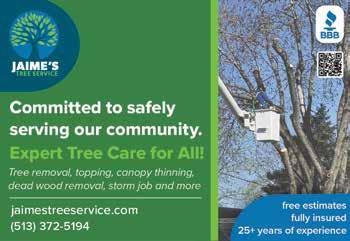

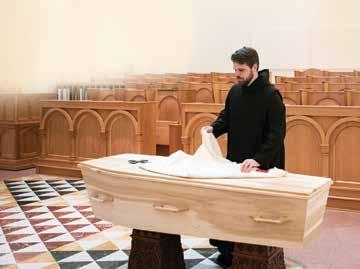
For over 25 years, Abbey Caskets has handcrafted elegant caskets and urns, supporting the prayer and work of the monks of Saint Meinrad Archabbey. Learn more at abbeycaskets.com.
Contact us to receive a 10% discount when you prepay for your Abbey Casket now through April 30, 2025.


Patricia McGeever

One year ago, only a storm sewer existed in an otherwise empty patch of grass at Saint Xavier High School. Now, it’s a sacred space known as The Grotto of the Holy Companions. Metal silhouettes stand in representation of St. Ignatius of Loyola, St. Peter Faber, St. Francis Xavier and a student.
“It was really important for the kids to see themselves as part of the Holy Companions,” explained the president of St. Xavier, Tim Reilly. Cut from steel, each silhouette is four feet wide, seven feet tall and an inch thick. Kevin Brady, a 1994 graduate and the school’s Makerspace Coordinator, designed the silhouettes.
Brady has a background in industrial manufacturing and a degree in industrial design. He previously owned an art studio with his wife. He views this project as some of his most significant work.
“It’s really kind of an incredible feeling,” he says.
Seven plaques are also posted at the grotto, inscribed with the Hail Mary in the seven different languages taught by the school. When the grotto was dedicated last fall, students recited the prayer in each of those languages.
“The goal was to make it feel inclusive,” said Reilly. “Every [language] is spoken in somebody’s home here.”
The grotto also holds a statue of the Blessed Mother, perched on a rock with the school chapel’s windows as the backdrop. At Reilly’s request, the statue was inspired by the image of Our Lady of Montserrat. It was created by well-known sculptor Tom Tsuchiya, whose popular works include the Pete
Rose statue outside Great American Ball Park.
“[Reilly] wanted a figure of the Madonna that could basically speak with the students,” said Tsuchiya, “[that could] connect with the students in a way that they [would] say, ‘That could be my mother.”’
The statue took about nine months to complete. Tsuchiya started by creating a small clay model. Once approved, he digitally scanned the design, enlarged it to a scale of five and a half feet tall and recreated the figure out of foam. Tsuchiya then enlisted the help of a St. Xavier art class.
“A number of students got involved to apply a thin layer of clay onto the sculpture,” said Tsuchiya.
Back at his studio, Tsuchiya refined it and then took it to the bronze foundry. The foundry made a mold, cast the statue and added the blue-green patina.
“I really love how the design worked out,” he said. “[It] can be appreciated from many different angles.”
The Grotto of Holy Companions invites spiritual growth for the young men who attend St. Xavier.
“It’s another space for devotion, contemplation and reflection,” said Reilly.
For Brady, it’s that and more.
“My dad went here. My grandpa went here. I’m expecting my sons to go here,” he said. “It’s a really good feeling to get to be a part of the history of the school in a small way.”



Las Hermanas de la Misericordia de las Américas dan bienvenida al Arzobispo designado Robert Casey como el próximo Arzobispo de Cincinnati.

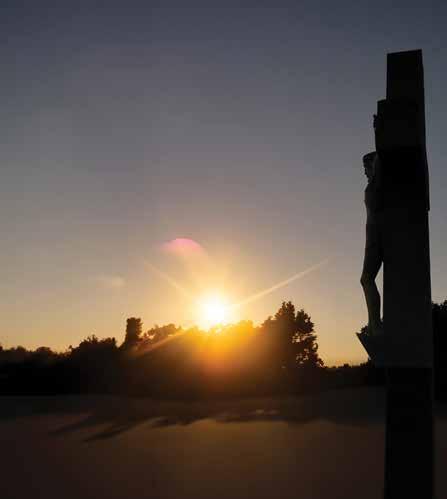















St. Isidore was born in Spain around the year 560. All three of his siblings are canonized saints: Leander, Fulgentius and Florentina. Isidore and his two brothers each served as bishops.
Isidore loved to learn. His older brother, Leander, taught him many of the same subjects we learn in school today. Hungry for knowledge, Isidore learned quickly, mastering Latin and learning some Greek and Hebrew, too. He was interested in everything: law, farming, road building and biology were just some of the subjects. Because he wanted to share everything he learned, he wrote it all down and became the first Christian writer to create an encyclopedia; it had 448 chapters! And it was used by teachers and students in their classrooms—for the next 900 years!
Isidore’s older brother died while still the archbishop of Seville, around the year 600, and Isidore became the new archbishop. He worked hard to reunite a divided Spain and to teach his people that Jesus truly is God. Isidore started many new schools and seminaries, and under him, Spain blossomed as a place of culture and learning.
In 1997 Pope Saint John Paul II named St. Isidore of Seville the patron of the internet.
Although Isidore lived more than a thousand years before the first computer was invented, his life’s work was to gather and share a huge amount of information. The next time you do a quick internet search, remember this holy man who learned and recorded so much information about the world.
St. Isidore died on April 4, 636, after serving more than 32 years as archbishop of Seville. St. Isidore, pray for the Archdiocese of Cincinnati as we welcome our next archbishop. Like you, may Archbishop-designate Casey help his people to grow in a love of learning and a love of God.

Archbishop Biology Building Encyclopedia Farming Internet Latin Law Road Spain Seminary

On February 8th, the Elder High School band performed in the “Magic Kingdom Electrical Parade” in Orlando, FL. In a Studio Soundtrack Session Workshop the following day, students worked with a Disney Music educator and participated in a real recording session.
AP Art students took an inspirational field trip to study artwork up close. Whether through materials, processes or ideas, each student found connections between their personal work and pieces at the museum.
The Saint Ursula Academy Women In Business Club participated in the X-Squared Competition at St. Xavier High School. Two teams from Saint Ursula Academy presented ideas for start-up businesses to a panel of judges. Team “Safe Wave” proposed a bracelet that can be used for GPS tracking, safety alerts and emergency response. They were named runner-up out of 45 teams and won a $500 cash prize!
Archbishop Moeller High School students spent a Sunday morning volunteering at Operation Ramp It Up, a nonprofit providing mobility to military veterans.




Untidy condition
1 Male members of religious orders (abbr.)
Cable TV station
Sleeper, maybe
Trickery
“___ Fideles”
“___ give up the ship”
Banned pesticide (abbr.) 9 What 63A would do
Be present at Mass
Poet Ezra
Unit of weight
Guide 18 Sea, to Sartre
Colors
Bird holders
Kukla’s pal
“So the king ordered Daniel to be brought and cast into the ___
We extend our heartfelt congratulations to Archbishop-designate Casey on his
Thank
We also wish to express our deep gratitude to Archbishop Schnurr for his years of dedicated service. Best wishes in your retirement.

den.” (Dan. 6:17)
26 Obstructs
27 Marks
30 “Destroy this temple, & in three days I will ___ it up.” (Jn. 2:19)
33 Saint Goretti
34 Whet
35 The root of all evils is the love of this, according to 1 Timothy.
37 Hometown of Jesus
38 Thor’s father
39 Drink to excess
41 Hollow in the earth
42 Our Mother of ___
43 Climbing device
44 “If Christ has not been ___, then empty is our preaching and empty, too, is your faith.” (1 Cor 15:14)
46 Talons
47 Lofty nest
48 “I will ___ you up on eagle’s wings”
50 Resinous deposit
52 VIP’s transport
55 Certain Padre
56 Photo
57 United States farmer’s org.
58 Outplay
59 Nathan told David that taking Bathsheba was like stealing this




FINAL WORD with Father Aaron Hess
“The Body of Christ.” “Amen.” Step to the side. “The Body of Christ.” “Amen.” Step to the side…
For most Catholics, this is the ritual at Mass. We are trained to, at the proper time, stand, fold up our kneeler, wait in line for our turn, receive Jesus, then walk back to our pew via the proper path. It’s been the same for decades—and how quickly it can become automatic, almost robotic. This is just what we do at Mass. But a danger in these repeated actions is that our minds easily go elsewhere, allowing the world to creep in. Here we are, receiving the greatest gift given to us as Catholics, the Source and Summit of our faith, and we are thinking about sports or wondering how quickly we can escape the parking lot after Mass.
As much as I wish it was otherwise, I fully understand how easy it is to fall into distractions—because I’m there too. It is all too easy to get distracted from reality—from entering into the beauty and mystery of the liturgy. When I celebrated Mass at the beginning of my priesthood, it was much easier to be in awe of what was happening through me: that my hands were holding the God of the universe, that Christ was using me to spiritually feed and nourish His flock. But now, how easy it is to think of other things. Do we have enough Extraordinary Ministers for Holy Communion? I’m dreading that hard conversation this afternoon. We are singing this song again for Communion... My mind gets distracted even when face-to-face with Christ Himself.
In those moments, I have to catch myself and intentionally refocus. I have to remember the joy of being a priest, of being Catholic and being able to receive the Most Blessed Sacrament. When I’ve brought Holy Communion to the homebound, many tear up in joy at the opportunity to receive Him, an opportunity they no longer take for granted. After being ordained a deacon, I recall the excitement in my grandparents’ voices over the phone when, during the COVID-19 shutdown, they learned they could receive the Eucharist from me. I think about the priests who smile while distributing Communion because of how much that

simple act of smiling has affected their flock.
I also imagine the joy that Jesus’ closest followers would have had after the Resurrection. The man they followed for three years, who taught them so much, who performed incredible miracles and loved them to the end: He seemed to be dead. The depth of their sorrow would have led to incredibly joyful reunions when Christ appeared to them! Peter jumps out of the boat and swims to Jesus on the shore. The two disciples on the road to Emmaus realize that their hearts were burning within them the entire time they walked. Mary Magdalene went in haste to share this joyfilled news with the apostles. And Thomas, after doubting, could only utter in awe, “My Lord and My God,” when he finally got to see Christ truly alive before him.
And is that not how we are called to receive this great gift of the Eucharist? With joy? With tears in our eyes at the privilege and opportunity before us? To jump out of our pews to reach Him at the shore? To feel our hearts burning within us as we unite physically and spiritually with the Lord? To just simply adore Him and whisper, “My Lord and My God” with complete love and trust?
So whether you are celebrating Mass or coming forward to receive Communion, do not take the action for granted. Recognize that this is the Lord who loves you, who desires to be close to you, who humbles himself time and time again, at every Mass, to be with you.
And that is something to rejoice in.

The Missionaries of the Precious Blood joyfully welcome Most Reverend Robert G. Casey as the new Archbishop of the Archdiocese of Cincinnati. We look forward to your leadership and spiritual guidance as you shepherd our faith community.
We offer this prayer for you:
"Heavenly Father, bless Archbishop Casey as he begins his ministry among us. Grant him wisdom, strength, and a compassionate heart to lead Your people with faith and love. May he be a true shepherd, guided always by Your grace. Amen."
With prayers and support,
The Missionaries of the Precious Blood

